General Insurance Blogs, Articles & Updates by - Magma HDI
Have us call you
- RENEW YOUR POLICY
- BUY NEW POLICY

How NCB Works for Car Insurance?
Your car insurance comes with an annual premium, which helps you bear the financial losses that may arise due to an accident. While a claim-free year may seem like a waste of money since you paid the premiums but didn't really use the benefits, it's really not the case. Firstly, having insurance provides you with mental peace that in the case of any mishap, your finances will be covered. Secondly, your insurance provider offers you discounts on your next year's premium if don't make a claim in the previous year. This is what is known as a No-Claim Bonus (or NCB). Keep reading to find out more on how to maximize savings on your Private Car Insurance In India.
What should you know about NCB?
Car insurance companies reward vehicle owners who drive safely with no-claim bonuses. The bonus becomes applicable if you get through one policy year without making a claim. The company pays the discount on Own Damage (OD) premium for each claim-free year
Typically, the amount can vary from one insurer to another. But, discounts begin at 20% per year and can go up to 50% for five claim-free years or more.
How does NCB work?
When a policyholder does not file any claim in the past one year, a no-claim bonus is initiated by the insurer.
As a result of this, you’ll get a discount on your annual premium amount subject to increase with every succeeding year.
Things to remember about NCB in India
An essential feature of NCB is that it relates to the policyholder, not the vehicle as it rewards you for precautions taken on your end. So, you can retain your NCB even if you replace your existing vehicle. Other prominent features of a no-claim bonus are:
• Applies even when you switch the insurer
When you switch from one insurer to another, the no-claim bonus remains unaffected. For example, if you have a policy from company X for the last five years with no claims made and you shift to company Y later on, the company Y will give you a benefit of 50% discount on your annual premium as NCB.
• Bonus increases every year
The insurance companies calculate your no-claim bonus in the range of 20%-50% on an annual incremental basis.
• Doesn’t apply on third-party cover
Keep in mind that the no-claim bonus applies to the own damage or OD cover on your auto insurance. So, if you have only the third-party (TP) cover, you’re not eligible for NCB. However, if you have both OD and TP protection, you’ll receive the discount proportionately.
Protecting your NCB
As NCB policyholders, you are entitled to a maximum discount of 50% for five claim-free years. However, this discount expires if you make even a single claim. In such a case, to protect your NCB, insurers give you the option of opting for an add-on cover. It covers your claim in order to protect your NCB.
Another great hack to keep your NCB would be to avoid making claims for smaller damages.
Head over to Magma HDI to find out more about NCB available with your private car insurance in India.

Monsoon Safety Checklist for your cars
Monsoons might not be the ideal time to drive around. The roads are slippery, and there are higher chances of meeting with an accident. However, the rainy season does not mean that you should stop driving altogether.
Instead, you should make sure that you follow some safety points to make sure that your driving experience is smooth and safe.
Here, we will look at some of the safety checkpoints that you should follow during monsoon. However, before we dwell on that, it is crucial to make sure that you get Car Insurance Online In India so that your car is covered in case of any unforeseen circumstances.
Fix those exhaust holes
Exhaust holes are made of iron, which means that they are vulnerable to rust. If there is a hole in your exhaust, then there are more chances for the rainwater to get in, besides the fact that a faulty exhaust is no food. Make sure that you have checked your exhaust for holes and other damages to ensure the smooth running of your car.
Cover your headlights
With time, your car headlights tend to develop spaces with them due to constant wear and tear. If they are damaged, then it is highly likely that the rainwater will get inside them, further leading to the damage. Make sure that you patch up these spaces so that your headlights are safe. Faulty headlights can lead to driving problems at night — something which no driver wants!
Check the door of your car
The doors in your car have a rubber attached to it. With constant usage, they may loosen up and make room for the raindrops to seep and ruin your interiors. To make sure that your interiors are as good as new, make sure to check on these doors now and then. If needed, replace them, as a repair might not be the easiest or the most convenient of ways.
Check your brakes
If you are driving around in rains, through clogged puddles, some water might just get deposited in your brake pads which can hinder the braking process and might lead to the deterioration of your brake pads. To get rid of the moisture, find a dry stretch of road and gently apply the brakes. The heat which comes out of friction will take the moisture away. If you find mud deposited on your pads, then go to a mechanic and get it clean. Remember that brakes are one of the most critical components of your car and you should always have them in good shape.
The way you treat your car is the way the car treats you. One cannot stress enough on the importance of taking care of vehicles. Magma HDI car insurance comes with affordable premium rates and features such as support for anti-theft devices, which can ensure that your car has a long and safe life.

First-time car insurance buyer's guide
Buying your first car can be a little overwhelming. You work persistently and save your hard-earned money aside to buy the vehicle of your choice. However, keeping your vehicle safe and secure is a necessary next step after your purchase. Accidents occur anytime and anywhere. Having a comprehensive car insurance policy to back up those damages is a wise decision to make.
These days, you may buy a car insurance policy online or by contacting a service agent at your convenience and get your vehicle insured. With a sound knowledge of car insurance policies, you can optimize your purchase and savour great benefits. Read along to have a better grasp of your first-time insurance purchase.
Purpose of Car Insurance
'Use it or lose it' is a common motto on which car insurance policy runs; to benefit from it, you need to pay a yearly premium. On the off chance that you are lucky enough not to have gone through a severe road mishap, you lose the premium sum paid for insurance. Then again, you get a No Claim Bonus, which is a quite significant sum beginning from 20% of the premium in the first year to 50% in the sixth, which is the reason why you shouldn't go for minor harms claim.
Different Covers under Policy Terms
A well-framed car insurance policy covers the damages due to natural disasters like earthquakes, floods, storms, typhoons, etc. Secondly, it includes the loss incurred due to manual disturbances like riots, theft, terrorist attacks, fires, etc. Thirdly, you as the insured can access the personal accident cover for your family if you die or suffer disability post-collision or mishap. Some company even offers benefits to co-passengers at the time of the accident. Your insurance policy covers the third-party liabilities like if you accidentally damage a third person's car or he dies of injuries due to collision, your insurer will protect you from legal repercussions.
Additional Benefits and Covers
One of the pluses of having a comprehensive car insurance policy is that you get various additional perks. It may raise the premium amounts a bit, but the level of your car's safety is maximized. Some of the add-ons can be;
- Windshield or car glass cover
- Accident cover for a paid driver or unknown passenger
- Depreciation waiver
- Personal belongings damage/theft cover
Hiring an Insurance Advisor
During the brainstorming sessions of buying your first auto insurance, it is natural to get perplexed with different coverage benefits. A simple way to tackle that confusion is to get in touch with an insurance agent who is well versed with different company's policy premiums and covers. He can advise you along the way to look over your shortlisted insurers by comparing their proposed rates. He may also identify premium discounts for your first-time policy purchase.
Going for a comprehensive car insurance policy is prudent. It gives a well-rounded cover for your car. So, it's highly advisable to get in touch with your financial experts and buy a car insurance plan today.

Your car premium may be affected by your location!
Car insurance is a critical aspect of car ownership, providing financial protection in accidents, theft, or damage to your vehicle. However, the cost of car insurance can vary depending on several factors, including your driving history, car make and model, and age. Apart from this, location is also one of the most significant factors affecting car insurance premiums. Where you live plays a crucial role in determining the cost of your car insurance premium. The influence of location on car insurance is a complex issue that involves several factors. Insurance companies analyse these factors when determining your car insurance premium.
This blog post will explore how your location affects your premium so that you are aware of the correct policy before buying car insurance. Without any further delay, let's get started.
1. Crime rate
One of the most significant factors that can affect your car insurance premium is the crime rate in your area. Insurance companies consider areas with high crime rates a severe risk, as they have a higher incidence of car theft and vandalism. This increased risk means you may have to pay a higher premium if you live in an area with a high crime rate.
2. Population density
Another factor that can affect your car insurance premium is the population density of your area. Areas with high population densities have more traffic, which increases the likelihood of accidents. Therefore, if you live in an area with a high population density, you may have to pay higher car insurance premiums.
3. Weather conditions
The weather in your area can also affect your car insurance premium. Regions with harsh weather conditions, such as snow, ice, or heavy rainfall, have a higher risk of accidents. Therefore, if you live in an area with extreme weather conditions, you may have to pay higher car insurance premiums.
4. Road conditions
Poor road conditions, such as potholes or inadequate lighting, can also increase the risk of accidents. Insurance companies consider the road conditions in your area when setting your car insurance premium. If you live in a location with poor road conditions, you may have to pay higher car insurance premiums.
5. Laws and regulations
The laws and regulations in your area can also affect your car insurance premium. Some states have minimum coverage requirements, while others do not. If you live in a state with high minimum coverage requirements, you may have to pay higher car insurance premiums.
6. Local insurance market
Finally, the local insurance market can also affect your car insurance premium. Insurance companies may charge different rates in different areas based on the level of competition in the local insurance market.
Therefore, if you live in an area with a less competitive insurance market, you may have to pay higher car insurance premiums.
When setting your insurance rate, companies consider factors such as crime rates, population density, weather conditions, road conditions, laws and regulations, and the local insurance market. Therefore, it is essential to understand how your location can affect your car insurance premium to make informed decisions when choosing a car insurance policy. Explore and compare car insurance policies to find the right one that fits your needs optimally.
Click HERE to learn more about the benefits of purchasing car insurance
Disclaimer: The information provided above is for illustrative purposes only. To get more details, please refer to policy wordings and prospectus before purchasing a policy.
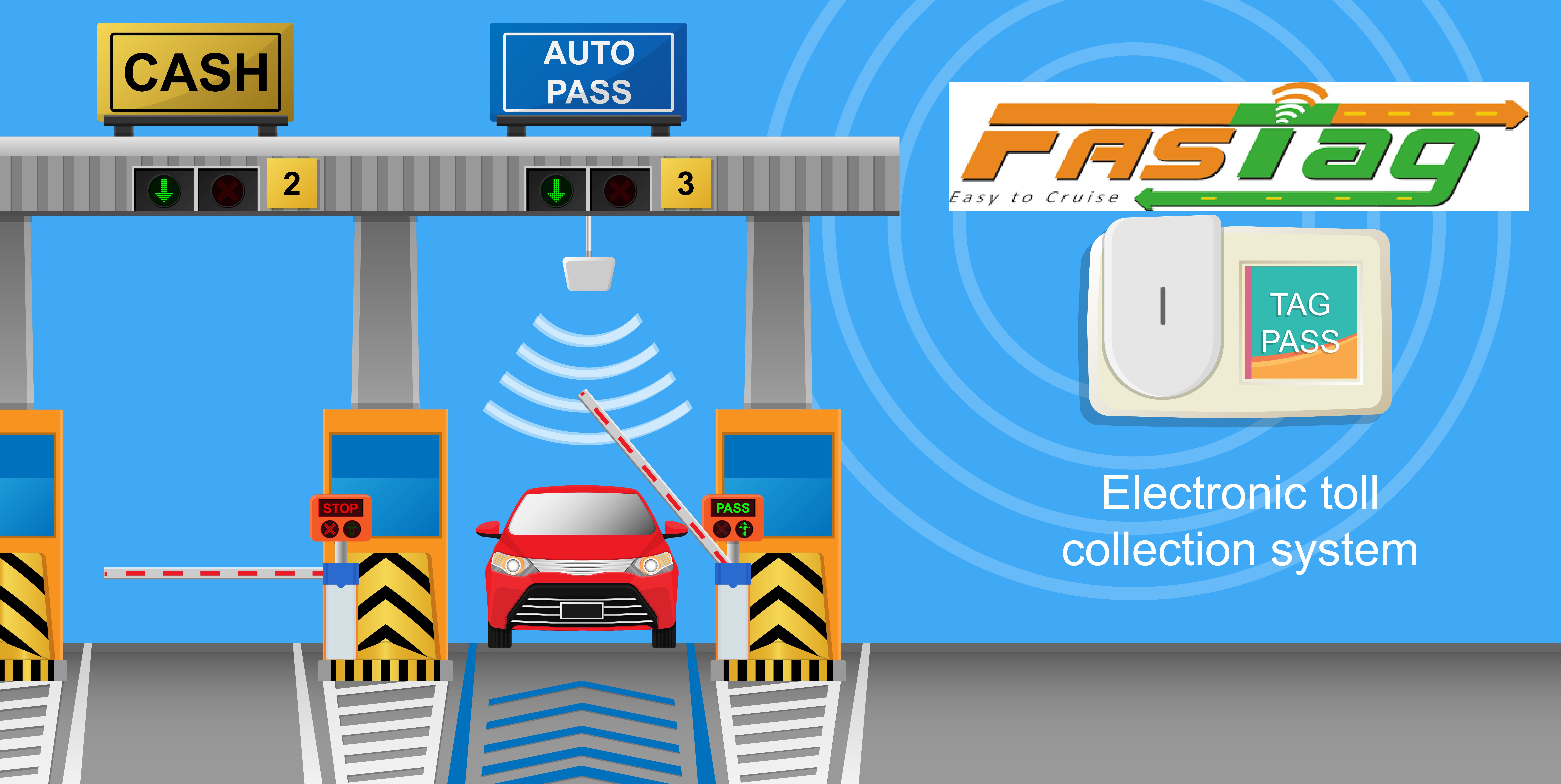
FASTag Uses and Benefits
Do you travel a lot by road? Are you tired of waiting for your turn at toll plazas on the interstate highways or expressways? Do you wish to get done with it as quickly as possible? If yes, then you must get a FASTag! As the name suggests, a FASTag is a tag which is a mean to ensure faster transit across toll plazas. The tag is placed on the windshield of the car and uses Radio Frequency Identification Technology. The tag is scanned by the tag readers placed at toll booths who then deduct the toll amount from the FASTag account. All toll plazas placed along the national highways are now using FASTag for payment of toll as per the guidelines of the government of India.
As the balance in FASTag reduces, the user needs to reload the balance in the linked wallet account or the linked bank account. By eliminating the need for cash payments at toll plazas, FASTag ensures a quicker and smoother flow of traffic.
The following reasons highlight how using a FASTag can help you save time on your journey: -
● Quick payment - As there is a FASTag affixed to your car, you wouldn't have to search your wallet for cash which ultimately reduces the duration of the transaction and your time is saved.
● Less fuel wastag - As you do not need to stop and restart your vehicle, less petrol or diesel is burned, which saves your fuel tank from draining quickly.
● Hassle-free recharge- You can easily recharge your FASTag using various methods like Internet banking, mobile wallet apps, NEFT, RTGS or even your credit and debit cards.
● Message alerts - Every time your FASTag is used, you get an alert SMS on the mobile number registered with the card which ensures the prevention of its misuse.
● Long validity- A FASTag is valid for five years, which means you need not worry about changing it frequently.
● No requirement of cash - The work of cash is taken over by the FASTag. Therefore, it eliminates the necessity of carrying cash for toll payments.
● Online portals- You can check the transactions made using your FASTag whenever you wish using specific web portals meant for the same.
Now, onto some Frequently Asked Questions: -
How to get a FASTag?
To buy a FASTag, you can ask the toll plaza employee for their sales department, or contact authorized agencies or banks that sell them. Many platforms offer car insurance quotes online and sell FASTag as well.
How much does a FASTag cost?
Generally, a FASTag can cost you around two hundred rupees for the purchase, which excludes recharge expenses.
Where is it placed?
FASTags are affixed on the windshield of the car in a very specific manner that allows the scanners placed at the toll plaza to scan it.
How to know if your card has been used?
As stated in the above benefits, a text message is delivered to the registered mobile phone when the FASTag is used. This is a sort of confirmation to the owner that payment has been made.
Do you need to maintain a certain balance?
You don't need to maintain a balance for sure, but yes there is a minimum value for a top-up of the tag which amounts to a hundred rupees.
Where is a FASTag valid?
Throughout the country, a FASTag can be used to make payments at toll plazas regardless of the city or state.
While getting FASTag will help you zoom seamlessly on the highways, do remember to check car insurance quotes online to get protection against possible accidents and incidents while on the road.

Do you experience frequent swelling in your legs? These can be the probable reasons
Medical issues are being observed as a rising problem, mainly because of drastic lifestyle changes, improper nutrition, and irregular physical activities. The best way to tackle medical adversities is by prioritising your health and never neglecting the symptoms that your body throws at you. Most health conditions develop over time due to your habits, while some are even hereditary.
One common issue is swelling in the legs, feet, and ankles. There can be multiple reasons for swelling, including physical injuries, medicinal reactions or allergies, and underlying conditions like cholesterol, diabetes, etc. If you see a frequent swelling pattern in your legs for a month, seek medical help, as it may be something to worry about. Leg swelling happens for two main reasons - edema and inflammation.
Let's explore more about them.
Factors causing edema
Several factors contribute to edema or fluid buildup in one or both legs. Here we discuss some major factors that require immediate medical assistance.
1. Congestive heart failure
When the heart is too weak to pump blood to body parts, this condition is termed congestive heart failure. Such a reduction in blood supply leads to fluid buildup, especially in the legs. Besides swelling, a person may also experience trouble breathing and constant tiredness.
2. Veins
Two vein issues can cause leg swelling and other problems in the body. Those are:
● Clotting in veins: A blood clot can form in any vein in your leg, which can break off and easily travel to your lung. This can lead to a life-threatening situation if left unnoticed. Other than swelling, if you also experience constant leg pain, cramps, or red or blue skin, immediately visit your doctor, as these might be the symptoms of vein clots.
● Chronic venous insufficiency and varicose veins: A person suffers from these conditions when the valves inside the leg veins cannot maintain the blood flow up toward the heart. Instead, the blood gets collected in pools, resulting in varicose veins. Other than swelling, you may also experience achy legs, pain after sitting and standing for too long, and dry, irritated skin.
If you experience these problems, visit the doctor to start your treatment.
3. Reaction from certain medication
Not every medication suits our bodies. Some cause side effects such as swollen legs, hair fall, irregular menstrual cycles, etc. Pain in the legs can also be a symptom of a medicine reaction. Notice the change in your body and talk to the doctor about getting alternative medicines that have zero to minimal side effects.
Factors causing inflammation
Some of the common causes that lead to inflammation in our body are listed below:
1. Arthritis
Anyone can develop arthritis at some point in their life. Due to the constantly changing environment, it is open to older adults. Diseases like gout, knee bursitis, osteoarthritis, and rheumatoid arthritis are becoming more common among people of all ages as they ignore proper care of their bodies, diet, and physical well-being.
2. Sprains and broken bones
Getting broken bones or twisting your ankle also causes swelling. It's our body's natural reaction to the injury as it moves the fluid and white blood cells into the injured area and releases the chemicals that speed up recovery. Some of the common injuries are mentioned below:
● Achilles tendon rupture: It is our body's largest tendon, and it connects the calf muscles to the heel bone. When it tears, you might experience a sharp pain in the back of the ankle and lower leg. The pain is so intense that a person may be unable to walk. ● Cellulitis: It's a severe infection that happens when bacteria get in through the crack in the skin. It is most common in the lower leg and ankles. Other than swelling, a person may experience tenderness, pain, a reddish skin area, blisters, and dimpled skin.
These were a few common reasons for frequent swelling in the legs. Your legs must be in the best shape to ensure pain-free and smooth movement. Give proper rest to your legs, and indulge in 10-15 mins of daily exercise like jogging or brisk walking.
Irrespective of the medical issues, one should always visit the doctor to rule out any worst outcome. Undoubtedly, any treatment can cost you heavily to your pocket. Therefore, getting health insurance from the best health insurance company in India to cover your medical expenses is ideal. Such insurance policies can help you in your time of need.
Click HERE to buy insurance from the best health insurance company in India.
Disclaimer: The information provided above is for illustrative purposes only. To get more details, please refer to policy wordings and prospectus before purchasing a policy.

Expert's guide on preventing fire outbreaks at home
A home is a place of comfort, protection, and security, but a fire breakout can rapidly turn it into dust. Various sources, including electrical failures, kitchen accidents, and malfunctioning appliances, can start fires. A fire breakout can be disastrous, causing significant damage to your property and personal items and possibly resulting in death. As a homeowner, you must take the essential precautions to prevent fires and safeguard the safety of your property and loved ones.
This blog discusses "expert's advice on preventing fire outbreaks at home." We'll review some of the best ways to protect your home from fire threats and the importance of obtaining the best home insurance in India. Following these suggestions and purchasing the appropriate house insurance coverage, you can protect your home from fire damage and enjoy peace of mind. So, without any delay, let's begin!
1. Install smoke alarms
Installing smoke alarms is one of the most effective strategies to avoid home fires. Smoke alarms detect smoke and notify you during a fire. This will help you to take the required precautions to prevent further damage. Install smoke alarms in each room and check and replace the batteries regularly.
2. Be careful of faulty appliances
Faulty appliances are one of the leading causes of home fires. Appliances must be handled with care and inspected regularly for flaws or damage. Always follow the manufacturer's instructions and use the appliances in accordance with their recommendations.
3. Check electrical wiring
Faulty electrical wiring is another major cause of home fires. Inspect your home's electrical wiring regularly for signs of wear and tear. Repair or replace any damaged wiring or electrical components immediately to avoid fire hazards.
4. Cook safely
Cooking mishaps are a significant cause of home fires. Practicing safe cooking skills and using caution when using the stove or oven is critical. Always keep combustible things away from the cooking area, and never leave the kitchen unattended when cooking.
5. Keep flammable objects away
Keeping flammable objects away from heat sources is critical to prevent home fires. Ensure that all flammable materials, such as cleaning solutions, paints, and petrol, are kept securely away from any heat source.
6. Have an emergency plan
Having an emergency plan can go a long way toward preventing home fires. Prepare an exit plan for a fire, and teach your family how to use fire extinguishers.
7. Obtain the best home insurance in India
The best home insurance in India is essential to protect your home from fire damage. A comprehensive house insurance policy covers fires, natural catastrophes, theft, and other unanticipated events. You get compensated for your loss and are relieved from financial stress due to the fire outbreak.
8. Conduct regular inspections
Inspecting your home for fire hazards regularly will assist in discovering potential threats and avoiding fire outbreaks. Periodically inspect your home, particularly the kitchen and electrical wiring, and take the required precautions to prevent fire threats. Install water sprinkler mechanisms, smoke detectors, and fire alarms to ensure safety against fire catastrophes.
Every homeowner is responsible for preventing fires in their homes. A fire breakout can be disastrous, causing significant damage to your life, property, and personal items. By following the expert's advice and taking the required precautions, you can ensure that your home is safe from fire threats and that you live in a secure atmosphere. In addition to these precautions, obtaining the best home insurance in India is necessary. A comprehensive house insurance policy covers fires, natural catastrophes, theft, and other unforeseen events, providing financial security and peace of mind. You can research alternatives and select the best home insurance in India to meet your requirements.
Click HERE to know more about how you can purchase the best home insurance in India and its benefits.
Disclaimer: The information provided above is for illustrative purposes only. To get more details, please refer to policy wordings and prospectus before purchasing a policy.

Here’s when you should change your bike’s engine oil
It is always necessary to change the engine oil timely to improve the performance and sustain the long life of your bike. However, many people ignore the importance of quality engine oil, which severely damages the engine and the bike's overall performance. Therefore, in this post, we'll discuss when you should change your bike's engine oil and why it is required to keep it in ideal condition.
When it is time to change the oil
To know when to change the bike's oil, you have many indicators that you need to keep an eye on. Your bike gives you several alerts indicating issues with the engine due to low oil levels or the need for replacement. You might hear weird sounds when giving ignition or revving your bike. Low oil level or poor quality oil can severely damage the engine and leave you to bear a massive repair and maintenance cost.
Below are some signs that will help you change the oil on time.
1. Read the manual
It might be possible that every bike has a different requirement when dealing with the engine. Read the bike manual to understand the guidelines and specific requirements for your bike. You can also learn about engine type, driving conditions, climate, etc.
2. Oil level
Check the oil level in your bike with the help of a dipstick. If you find the oil below the given level, you should look to change the oil.
3. Oil colour
You'll find a clear orange colour. As time passes and you use the bike regularly, the oil turns black due to impurities, wastes, and remains. When you find the oil dirty and get a foul smell, it is time to change it.
4. Engine performance
When you don't change the oil, you can't expect the desired performance from your bike. It is the case when your bike's oil turns black, and you should change it at the earliest. If left unchanged, you'll keep getting sluggish acceleration, reduced fuel economy, and poor performance.
5. Mileage
Generally, manufacturers suggest a rider to change the oil every 3,000–5,000 km. Changing the oil is always advisable when you cover this distance on your bike.
6. Unusual engine clatters
Untimely oil replacement might increase friction and wear on engine parts, leading to unexpected noises. So, if you hear any noise or clashes, you must change the oil. On the other hand, if you use your bike for high-performance racing, off-road biking, or long trips, you should always look to change the oil timely. These tours can strain your bike's engine and cause its performance to go down.
Points you must be aware of about the oil change
● Synthetic oils perform longer instead of the normal engine oils. You get better mileage and performance from your bike's engine. Also, thoroughly read the user manual to get clarity on oil changing.
● Regularly keep checking the oil level with a dipstick. Look at the colour and density of the oil.
● Visit the local garage and inspect your bike's engine for an oil change.
● Always use the best quality engine oil recommended by the bike manufacturer to avoid harming the engine and its parts.
It is evident to regularly monitor your bike's engine oil to enjoy a smooth riding experience and ensure the engine's longevity. Along with checking the engine oil's quality, you must also look for reliable bike insurance. Accidents can occur at any point. Therefore, you must protect your asset with comprehensive coverage. So, insurance and a timely oil change are two basic requirements that must be fulfilled on time for a stress-free and enjoyable riding experience.
Click HERE to buy reliable bike insurance.
Disclaimer: The information provided above is for illustrative purposes only. To get more details, please refer to policy wordings and prospectus before purchasing a policy.
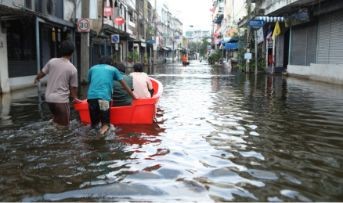
Why motor insurance is not enough: The importance of fire insurance for your vehicle
When protecting your vehicle, having a motor insurance is a legal requirement in most countries, including India. However, many vehicle owners mistakenly believe that motor insurance is enough to cover all kinds of damages, including those caused by fire. Unfortunately, this is not the case. Fire accidents can cause significant damage to your vehicle, leaving you with a hefty repair bill. This is where fire insurance comes to your protection. Fire insurance is a type of insurance that covers damages caused by fire, including damages to your vehicle.
This blog will discuss the types of damages fire insurance covers, the cost of fire insurance, and how to obtain fire insurance for your vehicle.
1. Motor insurance does not cover fire damage
While motor insurance covers damages caused by accidents, theft, and natural calamities, it does not cover damage caused by fire. If your vehicle catches fire, you cannot claim any compensation from your motor insurance policy. On the other hand, fire insurance is specifically designed to cover damages caused by fire.
2. Fire accidents are common in India
India witnesses a high number of accidental and intentional incidences of fire annually. Fire can spread quickly and cause significant damage to your vehicle in minutes. Having fire insurance for your vehicle will protect you against the financial impact of such accidents.
3. Fire insurance covers the cost of repair or replacement
If your vehicle is damaged by fire, fire insurance will cover the cost of repair or replacement, depending on the extent of the damage. This means you will not have to bear the entire cost of repairing or replacing your vehicle's parts, which can be a significant financial burden.
4. Fire insurance is affordable
Contrary to popular belief, fire insurance is not expensive. The cost of fire insurance for your vehicle will depend on various factors, such as the age, make, and model of your vehicle, as well as the extent of coverage you choose. However, fire insurance is a small price compared to the potential cost of repairing or replacing your vehicle after a fire accident.
5. Fire insurance provides peace of mind
Having fire insurance for your vehicle provides peace of mind, knowing you are protected against the financial impact of fire accidents. This is especially important if you rely on your vehicle for your livelihood or have invested significant money in purchasing or modifying your vehicle.
6. Fire insurance covers damages caused by riots
In a situation of riots and civil disturbances, vehicles are often targeted and damaged by fire. Fire insurance covers damages caused by such incidents, providing financial protection to your vehicle.
7. Fire insurance covers damages caused by electrical faults
Electrical faults can also cause fire accidents in vehicles. Fire insurance covers damages caused by electrical faults, providing financial protection against such incidents.
8. Fire insurance is easy to obtain
Obtaining fire insurance for your vehicle is easy and uncomplicated. You can purchase fire insurance as an add-on to your motor insurance policy or as a standalone policy from any insurance provider. Purchasing it is quick and hassle-free, and you can do it online from the comfort of your home.
While motor insurance is mandatory by law in India, more is needed to protect your vehicle against all kinds of risks. Fire accidents can cause significant damage to your vehicle, leaving you with a hefty repair bill. This is why it's essential to have fire insurance for your vehicle in addition to your motor insurance India. Fire insurance provides comprehensive financial protection against damages caused by fire, riots, electrical faults, and other such incidents.
Click HERE to learn more about motor insurance India and its benefits.
Disclaimer: The information provided above is for illustrative purposes only. To get more details, please refer to policy wordings and prospectus before purchasing a policy.

Here are the different types of back pain you must be aware of
Back pain is one of the most common problems everyone faces across the length and breadth of the country. Some people may face a dull pain in their back now and then, while for some, it may be constant. Others may experience sudden and excruciating pain in their back, that they may be unable to sit or walk properly.
The leading causes of back pain are a fall, an accident, lifting a heavy load, or age-related factors. Sometimes a medical condition can also result in back pain. The treatment varies with the category of back pain you are suffering from. Hence, let us first understand the different types of back pain.
1. Cervical pain
The cervical region in our body is the vertebrae of the neck. When you suffer from pain in or around your spine, it is a case of cervical pain beneath your head. It is a common type of pain that can last a few days to several years. The common causes of cervical pain include poor and slumped posture, physical strain, mental stress, herniated disc, tumors, and other health conditions.
In Cervical pain, you may feel the most axial neck pain in your neck or radicular neck pain that shoots to other body parts, such as your shoulders or arms. Cervical pain is not very serious and can be treated with treatments such as exercise, stress management, and medicines for pain.
2. Thoracic back pain
Thoracic back pain is the pain in your upper back. The main symptoms include fever, loss of weight, nerve pain or numbness in the legs or lower body, physical trauma, noticeable deformity, severe stiffness, and constant severe pain that does not go away even after a change in sleeping or sitting position.
Thoracic back pain should not be ignored because the upper portion of the spine is connected to the ribs that protect your heart and lungs. You should immediately see a doctor if you experience any of the above symptoms for a long time.
3. Middle back pain
Middle back pain occurs below your rib cage but above the lumbar spine region. You may feel similar symptoms, such as fever, chills, weight loss, dizziness, etc., as in thoracic back pain. However, sometimes the symptoms can be vague, and you cannot easily diagnose them.
Middle back pain is caused due to several reasons, such as obesity, stress, anxiety, lack of physical activity, smoking, and pregnancy.
4. Lower back pain
Lower back or lumbar pain is common in people over 30 years of age. It is caused by a strain on muscles or tendons in the back. Arthritis of the spine is also a common cause of lower back pain. The pain can be mild to severe, leaving people unable to walk, sleep, work, and do their daily activities properly.
The common causes of lumbar pain are obesity, back injuries and accidents, lifestyle, mental health, diseases, and age. Such pain can come and go suddenly, especially after you bend abruptly to pick up something or during a sport. Medications and physical therapy can treat it, while sometimes surgery may also be required to cure it.
Back pain is becoming common even among youngsters, making it a cause of concern. Excessive junk food intake causing obesity, a lifestyle with no physical activity, stress and anxiety, smoking, etc., are primarily causing back pain in the younger generation.
Furthermore, this problem is alleviated with age, injuries, and accidents. A good health insurance policy can be very helpful in case you require a long treatment or surgery due to prolonged back pain problems. It will make you financially secure and stress-free, even if your treatment lasts for several years.
Click HERE to buy the best health insurance in India.
Disclaimer: The information provided above is for illustrative purposes only. To get more details, please refer to policy wordings and prospectus before purchasing a policy.

Do you see black or white smoke from your motorcycle's muffler? These can be the reasons
When you notice black or white smoke coming out of your motorcycle's muffler, it is a sign that something is not working correctly. The smoke's colour makes it possible to tell what kind of problem the engine faces. White smoke typically indicates the presence of coolant or water mixing with the fuel in the combustion chamber. Whereas black smoke typically indicates a vibrant air/fuel ratio. The causes of black or white smoke can vary.
The following are some common causes of black or white smoke coming from a motorcycle's muffler:
Black smoke
1. Fuel injectors
The ability of the fuel injectors to supply the engine with the appropriate amount of fuel may be compromised if they are clogged or broken. Black smoke can result from incomplete combustion caused by a shortage of fuel.
2. Spark plugs
Black smoke is produced when the air/fuel mixture does not burn completely due to a damaged spark plug.
3. Inappropriate fuel blend
Black smoke can result from incomplete combustion, caused when the fuel combination is vibrant or too much fuel in the air/fuel mixture. This may occur if the motorcycle uses power with a more excellent octane rating than the engine needs.
4. Air filter
Black smoke may result from the engine receiving less air than required due to a blocked or dirty air filter. A vibrant air/fuel mixture caused by a dirty air filter can result in incomplete combustion.
5. Carburetor
Black smoke can also be produced by a vibrant air/fuel mixture from a dirty or faulty carburetor.
6. Exhaust system
Black smoke can result from an accumulation of exhaust gases brought on by a damaged or blocked exhaust system.
7. Carbon accumulation
An engine's combustion chamber, valves, and pistons may accumulate carbon deposits over time. These carbon deposits can interfere with combustion and lead to black smoke.
8. Oxygen sensor malfunction
The oxygen sensor determines how much oxygen is in the exhaust gases. The oxygen sensor may be unable to provide the engine control module with reliable readings if it is broken or faulty. This can cause the engine to receive insufficient fuel, leading to black smoke.
White smoke
1. Overheating
If the engine operates excessively, the coolant may boil and combine with the fuel in the combustion chamber. Additionally, this may cause the silencer to release white smoke.
2. Incorrect fuel blend
White smoke may result from an excessively lean fuel combination or an air/fuel mixture that contains too much air. This might occur if the motorcycle is powered by fuel that doesn't meet the engine's octane requirements.
3. Transmission fluid
A motorcycle with an automated transmission may emit white smoke from the silencer if the transmission fluid is burning.
4. Defective fuel injectors
The engine may not receive the proper amount of fuel if the fuel injectors are not operating correctly. White smoke can result from incomplete combustion caused by a lack of power.
5. Coolant leak
Coolant can leak into the combustion chamber if the engine's head gasket is damaged or the cylinder head is cracked. White smoke will flow out of the muffler when the engine runs because coolant and fuel will combine.
6. Water in the fuel
White smoke may emerge from the silencer if the fuel contains water. This may occur if water has collected in the motorcycle's fuel tank due to prolonged sitting.
7. Defective glow plug
The glow plug heats the combustion chamber, which helps the engine start. White smoke may result from incomplete combustion caused by an inaccurate glow plug.
A motorcycle's muffler may emit black or white smoke, indicating several engine issues. It is essential to determine the root of the problem and take quick action to fix it to stop the engine from suffering additional damage. Taking your motorbike to an expert mechanic for diagnostic and repair is advised if unsure of the cause. Motor insurance provides financial security in the case of an accident or damage to your vehicle. It is advisable to buy motor insurance online as it eliminates the need for paperwork and mediators, which may result in cost savings on insurance premiums.
Click HERE to buy motor insurance online.
Disclaimer: The information provided above is for illustrative purposes only. To get more details, please refer to policy wordings and prospectus before purchasing a policy.
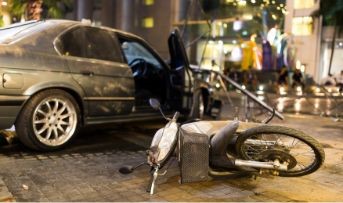
Let's have a look at some common motorcycle injuries that you must know
Motorcycles are open vehicles with no outer enclosures to protect you in case of a fall or an accident. Also, they are smaller than cars, making them less prominent and visible on the roads. This makes motorcycle riders more susceptible to accidents that can cause injuries, many times so severe that they can result in the loss of lives of the rider and the pillion.
Motorcycles are also lighter in weight, meaning they may drag on the road for a few metres after a fall or crash. This may also cause severe injury to the passengers. Let's look at some common motorcycle injuries you must know.
1. Rashes
Rashes are the most common injury that motorcycles can cause. When you fall from your bike, your arms and legs are most susceptible to rubbing against the ground's surface. This causes rashes on your skin, the severity of which depends upon the intensity of the drag or fall. If you were riding your motorcycle at high speed, you would likely develop severe rashes and bleeding, which will take a few days to heal. You can even develop infections and nerve damage.
2. Fracture
A fracture or multiple broken bones are also a common motorcycle injury. The impact of your fall on the ground can be intense enough to break or crack a few bones in your body. A fracture commonly occurs in the legs, forearms, or pelvis bones. A severe accident can even cause damage to your skull and rib cage.
3. Head injuries
The impact area of your fall from the motorcycle is often your head and neck. You may face severe head injuries, especially if you are not wearing a helmet. Youngsters tend to drive their motorcycles fast and recklessly, and falling at such high speeds can be fatal to the head and life.
4. Spinal and neck injuries
Your neck and the spinal cord may face irreparable damage if the main impact area is the neck or back. Such damage can be intense and extremely painful. The pain can be chronic, and the accident can result in paralysis, nerve damage, and even death.
5. Hands, arms, and legs
After a fall due to a motorcycle accident, you instinctively throw out your arms and land on them. Your hands and arms immediately bear the brunt of the fall, and you may suffer deep rashes, cuts, and broken bones. Such accidents can also result in nerve damage and paralysis of your arm.
Similarly, the main impact area of a motorcycle accident is your legs. In most accidents, you will hurt your legs by suffering rashes, deep cuts, or a fracture.
6. Muscle tear
A motorcycle accident often does not break your bones or cause a fracture. Instead, it causes muscle tears, soreness, and internal muscle damage. Since the impact is internal, recovery also takes a lot of time.
7. Burns
Severe burns are also a possibility when you meet with a motorcycle accident. This rarely occurs when the fall or accident is intense enough to spill the fuel from the fuel tank during the crash. The motorcycle may immediately catch fire, causing severe burns. Burns cause intense pain and take a long time to heal.
A motorcycle accident can happen unannounced with anyone, anytime and anywhere. You should always wear protective bike gear while riding your motorcycle, such as a protective jacket, knee and arm pads, gloves, etc. A helmet is a must and should be worn every time you ride your motorcycle. You should also choose a good motor insurance company in India to protect your vehicle from damages due to an accident. It will protect you financially and cover all the repair costs when your bike needs repair work.
Click HERE to buy insurance from the best motor insurance company in India.
Disclaimer: The information provided above is for illustrative purposes only. To get more details, please refer to policy wordings and prospectus before purchasing a policy.

Can depression be genetic? Let's discuss
As healthcare and mental health awareness continue to grow, the question of whether depression can be genetic has become more prevalent. Depression is a debilitating mental illness affecting millions worldwide and can be challenging to diagnose and treat. While various factors can contribute to the development of depression, including environmental and social factors, the role of genetics in the condition has been a subject of research for many years. Understanding the genetics of depression and its impact on mental health is crucial to providing appropriate care and treatment for those who need it.
We'll also understand the importance of early detection and treatment and how health insurance policies can play a vital role in curing depression. Let's get started!
1. Understanding depression
Depression is a complex mental illness that can manifest in various ways, including feelings of sadness, hopelessness, and despair. While it is a common mental health condition, depression can be challenging to diagnose and treat due to the wide range of symptoms that can be present.
2. The genetic component of depression
Research has shown a genetic component to depression, confirming that it can run in families. Studies have found that people with a family history of depression will likely develop the condition. It is advisable to consult a doctor and get routine tests done.
3. Other influencing factors in depression
While genetics play a role in depression, it is not the only factor contributing to the condition's development. Environmental components, such as stress, trauma, and life events, also significantly impact your mental health.
4. The genetics of depression: What we know so far
There is still much to learn about the genetics of depression, but researchers have made some significant strides in recent years. Studies have identified several genes that may be involved in the development of depression, including those that regulate serotonin and other neurotransmitters in the brain.
5. The importance of early diagnosis and treatment
Whether depression is genetic or not, early detection and treatment are critical to managing the condition effectively. People who are at risk of developing depression due to their family history should be screened regularly and should seek treatment if they begin to experience symptoms.
6. The role of health insurance in depression treatment
For many people, the cost of depression treatment can be a significant barrier to accessing proper care. Health insurance policies can help to mitigate these costs by covering the cost of therapy, medications, and other treatments.
7. Health insurance policy renewal and mental health coverage
When it comes time to renew your health insurance policy, reviewing your coverage for mental health treatment is essential. Ensure that your policy covers the cost of therapy and medications for mental health treatment or if there are some deductibles you may be responsible for.
8. The importance of spreading awareness about mental health coverage
If your health insurance policy does not provide adequate coverage for mental health treatment, it is essential to speak up for better coverage. Contact your insurance provider or speak to your employer's benefits department to discuss your options and work to improve your coverage.
In conclusion, depression can be a complex and challenging condition to manage, but with early detection and treatment, it is possible to live a fulfilling life. While genetics play a role in the development of depression, environmental factors, and other influences can also contribute to the condition's onset. Health insurance policies can help to make depression treatment more accessible and affordable. However, verify all the policy features at the time of health insurance policy renewal. Working together can improve mental health care and help more people get the support and treatment they need to thrive.
Click HERE to learn more about your health insurance policy renewal and how to do it quickly.
Disclaimer: The information provided above is for illustrative purposes only. To get more details, please refer to policy wordings and prospectus before purchasing a policy.

The hidden indicators in your blood test report you might not be aware of
Healthcare professionals frequently utilise blood tests to identify and track a range of medical disorders. A blood test is a medical process in which a medical professional takes a sample of a patient's blood. Then the sample is examined in a lab to measure different chemicals in the blood. Blood test costs are frequently covered as part of health insurance plans in India. Depending on your chosen insurance plan, the scope of coverage and the particular blood tests covered may differ.
It would be best if you were made aware of the significance of several hidden indicators which can provide important details about your general health and assist in detecting future health issues.
1. Vitamin D
Vitamin D helps immune health, bone health, and other bodily functions. Numerous health issues, including osteoporosis, depression, and an elevated risk of several malignancies, can be brought on by low vitamin D levels. People who reside in places with little sun exposure are more likely to have vitamin D deficiencies.
2. Thyroid hormones
The thyroid gland releases hormones that regulate the body's metabolism and production of energy. Fatigue, weight gain, and depression are just a few health issues that are caused due to low thyroid hormone levels. Other causes of thyroid abnormalities include autoimmune diseases and radiation exposure.
3. C-reactive protein (CRP)
C-reactive protein (CRP) is produced in the body in response to inflammation. Increased CRP levels can signify several medical conditions, including infections, autoimmune diseases, etc. Cancer, diabetes, and arthritis are a few examples of chronic diseases that can be contributed to inflammation in the body.
4. Triglycerides
Blood contains a specific kind of fat called triglycerides. Cardiovascular disease risk is enhanced by having high triglyceride levels. Obesity, a high-carbohydrate diet, and particular medications are just a few of the things that might raise triglycerides.
5. White blood cells
White blood cells are a specific type of blood cell that aids in the body's defence against illness and infection. Abnormal white blood cell counts can indicate a disease such as leukaemia and autoimmune disorder which can weaken bodily function and be life-threatening.
6. Iron
An essential ingredient called iron is required for the production of haemoglobin. This protein is found in red blood cells that transport oxygen throughout the body. Anaemia is the condition when the body produces insufficient red blood cells, and low iron levels can cause it. In addition to other symptoms, anaemia can make you tired and worn out.
7. Homocysteine
Homocysteine is an amino acid produced during the metabolism of methionine, an essential amino acid. Elevated homocysteine levels are linked to a higher risk of cardiovascular disease, stroke, and Alzheimer's.
8. HbA1c
Diabetes is diagnosed and managed using the HbA1c blood sugar control indicator. The risk of consequences like kidney damage, nerve damage, and cardiovascular disease can increase when HbA1c values rise because they signify poor blood sugar control.
9. Creatinine
Creatinine is a waste product filtered out of the body by the kidneys and produced by muscle metabolism. Several symptoms, including fatigue, fluid retention, and high blood pressure, can be caused by elevated creatinine levels. Elevated levels of creatinine can be an indication of kidney damage or injury.
An individual's health status can be determined a lot by blood tests. In addition, there are a lot of hidden indicators in these tests that can reveal important information about your health conditions. Discussing blood reports with your healthcare professional is essential to understand your overall well-being. The cost of diagnostic testing, including blood tests, can be covered under health insurance plans in India. These plans could be excellent for people who want frequent check-ups to monitor their health status. It is always advisable to verify all the terms with your insurer and do thorough research before purchasing health insurance plans in India.
Click HERE to browse different health insurance plans in India.
Disclaimer: The information provided above is for illustrative purposes only. To get more details, please refer to policy wordings and prospectus before purchasing a policy.

The power of positive thinking: How to develop a growth mindset for success
Our way of thinking and approach to life significantly impact our success and well-being. The growth mindset, or the power of positive thinking, is a well-known concept that has gained widespread recognition in recent years. This mindset emphasises that we can develop our abilities and intelligence through hard work, dedication, and a positive attitude. Here, we will explore the power of positive thinking and how to develop a growth mindset for success.
What is a growth mindset?
The term "growth mindset" was coined by a well-known psychologist and researcher, Carol Dweck. A growth mindset defines that one's abilities can be developed and polished through hard work and perseverance. People with a growth mindset view challenges and failures as opportunities for growth and steer themselves out by making strong comebacks to achieve their goals. In contrast, people with fixed mindsets believe their abilities and intelligence are predetermined and cannot be changed. They shy away from hardships and give up easily when faced with challenges.
The power of positive thinking
Positive thinking is a crucial component of developing a growth mindset. It involves focusing on the positive aspects of a situation and looking for opportunities to learn and grow. Positive thinking can help develop a growth mindset by:
● Changing your perspective: Approaching challenges and failures with a positive mindset enables you to view them as opportunities for growth. You can learn valuable lessons from the experiences and avoid the thoughts that demotivate you.
● Increasing resilience: Positive thinking helps to develop resilience or the ability to recover from adversity. Focusing on the positive aspects of a situation equips you to tackle problems and endure difficult times.
● Boosting confidence: Positive thinking helps to boost your confidence and self-esteem. When you believe you can shine your abilities and overcome hurdles with a passionate intent, you're more likely to take risks and accomplish your goals.
How to develop a growth mindset?
Developing a growth mindset requires time and effort, but it's worth it. Following are a few ways to develop a growth mindset:
● Embrace challenges: It is the best thing to do to make growth chase you. Seek out challenges rather than running away from them. Every new challenge gives you a new experience that shapes your skills and confidence to improve.
● Learn from failures: When you experience failures or setbacks, reflect on what you can learn from those experiences. Consider what you could have done differently and how to improve next time.
● Cultivate a positive mindset: Focus on the positive aspects of a situation and look for opportunities that promise you contentment. Practice gratitude, positive self-talk, interact with positive people, and consume motivational content to help shift your mindset to a more positive outlook.
● Emphasise effort over talent: You're more likely to succeed when you work hard and put in the effort. Be consistent with what you do and continue to work hard unless you achieve your objectives.
A positive mindset is essential when caring for our health and well-being. By maintaining a positive outlook, we can stay motivated to lead a healthy lifestyle, seek the best healthcare options, and take steps to prevent illness and disease. Similarly, developing a growth mindset can help us stay motivated to achieve our goals and overcome challenges related to our health.
Choosing the best health insurance in India is just one of the many steps to ensure we care for ourselves and our loved ones in the best way possible. The power of positive thinking and the growth mindset can profoundly impact your success and happiness. By accepting challenges, learning from failures, and cultivating a positive mindset, you can develop the skills and abilities needed to be successful. Developing a growth mindset takes time and effort, but you can achieve great things with dedication and hard work.
Click HERE to buy the best health insurance in India.
Disclaimer: The information provided above is for illustrative purposes only. To get more details, please refer to policy wordings and prospectus before purchasing a policy.
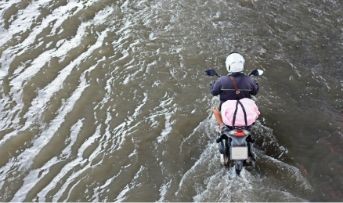
The complete guide for bike safety during floods
Biking is a well-liked form of exercise and transportation, but it may also be dangerous when floods occur. One of the natural calamities that occur most frequently worldwide is flooding. As a result, the nation suffers severe socio-economic losses. Floodwaters can cause highway disasters, create dangerous situations, and increase the risk of electrocution. You can, however, ride your bike safely during floods if you take the proper safety measures.
Even though caution can significantly lower the chance of accidents and injuries when biking through floods, unexpected events can still occur. Bike insurance offers financial security and peace of mind in such circumstances. Here's a detailed guide to biking safely during floods.
1. Plan your route
It's essential to consider regions prone to flooding, such as low-lying areas, riverbanks, and bridges, while planning your motorcycling route during a flood. Always stay on high ground and avoid these regions. Plan a path that stays clear of the flooded areas using online maps.
2. Use lights
Motorcycle lights make you more visible to other drivers when it's dark or low light. Ensure that your bike has lights and reflectors. It would help if you also considered bringing a tiny torch or headlamp in an emergency.
3. Stay informed
It's essential to be aware of local conditions before riding a bike during a flood. If there are flood warnings or advisories, keep an eye on local weather forecasts and news updates to stay informed. Avoid riding in regions with flood warnings or advisories and take a different route.
4. Wear appropriate gear
You must wear appropriate clothing to protect yourself from the rain and water when riding through a flood. Put on a waterproof jacket and a pair of trousers to keep dry. Ensure that your shoes are water-resistant as well. Wearing reflective clothing or gear can improve your visibility to other drivers.
5. Slow down
Riding in flooded regions requires extra caution and slowing down. Floodwaters may be deeper than they appear and may cover trash or other obstructions. To avoid any unforeseen dangers, slow down.
6. Watch out for dangers
Be cautious when riding through floodwaters to avoid obstacles like downed trees, electricity lines, and perhaps washed-in debris. Avoid these risks whenever possible. If you encounter a downed power line, maintain a distance of at least 10 feet and contact your local power company immediately.
7. Follow the guidance of authorities
It's essential to follow the advice of emergency officials and local authorities during a flood. Road closures and evacuation orders may be included in this. Consult with local authorities first if you are unsure whether riding in a particular location is safe.
8. Stay on marked bike paths
Stick to marked riding paths or roads that are open and safe for commuting. Avoid any areas that are closed off or that the authorities have blocked. When a road is closed, or a diversion is indicated, follow the instructions on the sign.
9. Avoid fast-moving water
Avoid riding your bike across the moving water since it might easily knock you off and take you with it. If you must ride your bike through the water to cross a flooded area, walk your bike instead. Remember that riding a motorcycle through even a few inches of water can be fatal.
Additional safety measures and close attention to detail are needed when biking during a flood. You can safeguard your safety when biking through floods by carefully planning your route and following official guidance. Remember, it's always better to avoid biking in dangerous conditions whenever possible. Bike insurance can offer significant financial protection in unforeseen circumstances like floods or other conditions. Review your policy carefully and take the appropriate safety measures to safeguard you and your bike.
Click HERE to invest in the bike insurance policy.
Disclaimer: The information provided above is for illustrative purposes only. To get more details, please refer to policy wordings and prospectus before purchasing a policy.
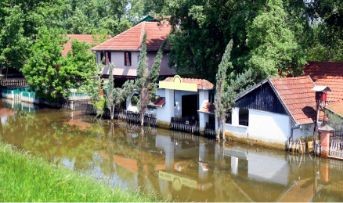
Here are some ways to ensure the protection of your dear ones and assets from flood
Floods are natural disasters that can happen unexpectedly, causing damage to property and putting lives in danger. Even while you can't always stop a flood from occurring, there are precautions you can take to safeguard yourself and your property from damage.
Personal accident insurance India does offer protection in an accident that leaves someone injured or dead. But buying a separate flood insurance policy to protect yourself and your property from flood damage will be ideal. Typically, this policy will cover flooding-related harm to your house, assets, and other property.
Let's look at a few guidelines to protect your loved ones and assets against flooding:
1. Know your risk
The first step in preventing floods from harming you and your belongings is to become aware of your area's flood risk. The likelihood of flooding varies from place to place depending on geography, elevation, and proximity to water sources. Consult the Flood Map Service Centre to determine your flood risk. You can contact your local government or emergency management office to learn about flood dangers.
2. Buy flood insurance
Getting flood insurance is one of the most crucial things you can take to safeguard your home against flood damage. You'll need a particular flood insurance policy to protect your property since standard homeowner's insurance sometimes doesn't cover flood damage. The National Flood Insurance Programme (NFIP) and private insurers offer flood insurance. It's important to carefully read your policy to understand what it covers and how much insurance you have.
3. Elevate your property
Consider elevating your home if you live in a flood-prone location to reduce the chance of heavy damage. Raising your house or property above flood level is called promoting it. It can be accomplished in many ways, including constructing a raised foundation or adding stilts or piers. You can reduce the cost of your flood insurance by elevating your home.
4. Safeguard important documents
Important papers, including insurance policies, forms of identification, etc., should be kept in a secure location in case of a flood. Store these documents in a position that won't likely be affected by flooding. Store them in a waterproof container, like a safe or waterproof bag. You can also make digital copies of your key documents and store them safely online or on a portable hard drive.
5. Install flood-barriers
By keeping water from entering your home, flood barriers can help safeguard your property against flood damage. Sandbags are typical flood barriers to build a wall against flood waters around your home. Another form of flood barrier that is quick and simple to install is a water-filled barrier. Levees or other permanent flood barriers can also be implemented, offering long-term protection against flood damage.
6. Stay informed
You can prepare for a flood and reduce the risk of damage by staying updated about flood alerts and advisories. You can sign up for alerts from emergency management agencies and follow local weather reports online. Follow local officials' advice and vacate the place if a flood warning is issued for your area.
7. Have an emergency plan
You and your family can stay safe in the case of a flood if you have an emergency plan in place. Your emergency plan should contain escape routes, emergency contacts, and a list of things you must take while leaving. To ensure everyone is prepared, practise your emergency plan with your family.
Protecting you and your property against flooding is essential to reduce damage and safeguard your well-being. By looking at flood maps and learning about the local flood history, you can estimate the risk of flooding. Additionally, an emergency plan should be created that details evacuation routes, contact options, and emergency supplies. In addition to personal accident insurance India, buy a separate flood insurance policy to protect assets from the flood.
Click HERE to buy a reliable personal accident insurance India policy.
Disclaimer: The information provided above is for illustrative purposes only. To get more details, please refer to policy wordings and prospectus before purchasing a policy.
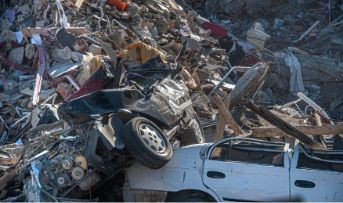
Complete guide to ensure the safety of your car during an earthquake
As natural catastrophes become more frequent and severe, safeguards are critical to keeping our vehicles safe. As car owners, we put a lot of time and money into buying and maintaining our automobiles. Therefore, we must protect them against disasters like earthquakes. Not only earthquake damages are expensive to fix, but they can also jeopardise your and your family's safety. In this article, we will go through a complete guide to ensure the safety of your car during an earthquake. We will review detailed points to protect your vehicle and yourself from potential earthquake damage.
In addition, we will discuss the significance of online car insurance and how it can assist in protecting you financially in the event of earthquake damage. Following these tips may make your car as safe as possible during an earthquake and be better prepared for future natural disasters. Let's get started.
1. Select a secure parking spot
Choosing a safe parking area is critical to ensuring your car's safety during an earthquake. Avoid parking in places prone to landslides or with many trees that could fall on your vehicle. Look for parking spaces in open areas away from buildings and trees, such as parking lots. Additionally, attempt to position your car facing outwards so you may quickly evacuate in an emergency.
2. Safeguard your vehicle
When an earthquake strikes, your car may shake severely, and anything inside may become lethal projectiles. As a result, it's always advisable to keep your car's contents intact and unloose. Protect any unsecured goods inside your vehicle, such as computers, luggage, and other items. Additionally, ensure that your car is in good shape and that all parts, including wheels and tyres, are securely fastened.
3. Keep valuable documents safe
Maintaining your car insurance documents, registration papers, and other important documents is required in a secure location. Always keep them in a waterproof and fireproof container in your car or a safe place at home. Keep a digital copy of your documents on your phone or other digital devices.
4. Check your online car insurance protection
Earthquakes can cause severe damage to your vehicle, so ensure your car insurance is updated. Verify your online car insurance policy covers earthquake damage. Also, be sure you understand what your insurance policy covers and what it does not.
5. Prepare an emergency kit
During an earthquake, having an emergency pack in your car is critical. A first-aid kit, a torch, a blanket, a map, and a portable charger should all be included in the kit. You can also have some non-perishable food and drink.
6. Stay in your car
During an earthquake, remain inside your vehicle and fasten your seatbelt until the shaking stops. If you're driving, pull over to a safe location, turn off the engine, and remain inside your vehicle until the shaking stops.
7. Be cautious after the earthquake
Drive with caution after the earthquake. Examine your vehicle for any apparent damage, such as dents, scrapes, or shattered windows. If you fear that your car has suffered substantial damage, wait to drive it until a specialist has inspected it.
8. Prepare for future earthquakes
Earthquakes can occur anytime, and preparing for future quakes is critical. Keep your car in good shape and regularly serviced to guarantee its functioning. Consider adding safety measures, such as a GPS tracker, an alarm system, or a dashcam, to protect your vehicle in the event of damage.
In conclusion, securing the safety of your vehicle during an earthquake is critical. The above safety tips can help safeguard your car from harm during an earthquake. Protect yourself and your family by adequately preparing and caring for your vehicle during an earthquake. You can explore all the insurance options available from the convenience of your home and purchase online car insurance that caters to your needs in the best ways possible. Remember that safety comes first, and taking precautions now might save you a lot of trouble later.
Click HERE to learn more about purchasing online car insurance and its benefits.
Disclaimer: The information provided above is for illustrative purposes only. To get more details, please refer to policy wordings and prospectus before purchasing a policy.
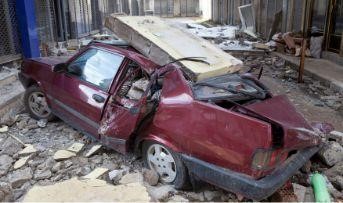
The future of car insurance coverage for earthquakes in India: Trends and innovations
The frequency and intensity of earthquakes have grown in recent years, inflicting property damage, including car damage. Car owners are required by law to carry car insurance, and as a result, insurance policies are expanding to cover earthquake damage. The future of automobile insurance coverage for earthquakes in India is a critical issue that impacts both car owners and insurance providers.
In this space, we will look at the various types of coverage available, the role of technology, and how car owners may guarantee their vehicles the best coverage in the case of an earthquake. Let's begin!
1. Increase in natural disasters
Natural disasters such as earthquakes have become more common in India. Since India has been witnessing more earthquakes with magnitudes greater than 3.0 recently, car owners must have insurance coverage to safeguard their valuable assets against the adversities of an earthquake.
2. Comprehensive car insurance
Comprehensive car insurance protects your car against natural disasters such as earthquakes. It differs from a third-party liability policy, which solely covers damages to a third party in the event of an accident. Car owners should think about getting comprehensive car insurance that covers earthquake damage.
3. Earthquake coverage add-ons
Aside from comprehensive insurance, vehicle insurance companies often provide add-ons to cover specific natural disasters such as earthquakes. The optional features include engine protection, roadside assistance, and 0% depreciation. Car owners should consider obtaining these add-ons to supplement their coverage.
4. Usage-based car insurance
In India, usage-based automobile insurance coverage is becoming more common. These policies base premiums on vehicle usage, and the car owners who drive their vehicles less frequently pay a lower rate. In the future, usage-based automobile insurance policies can be tailored to provide earthquake coverage based on the vehicle's geographical location.
5. Telematics
Telematics uses technology to monitor a vehicle's performance and usage. In the future, automobile insurance companies may utilise telematics to track the car's location and provide coverage for earthquake damage based on the vehicle's location.
6. Artificial Intelligence (AI)
Artificial intelligence can be used to analyse data and generate customised insurance plans. In the coming years, AI might analyse earthquake-prone locations and offer customised vehicle insurance coverage to protect against earthquake damage.
7. Self-driving cars
As self-driving cars become more prevalent in India, it is crucial to remember that just like regular cars, they are exposed to theft, loss, or damage through natural calamities such as earthquakes, storms, or human-made issues like riots. As a result, the growing demand for customised insurance coverage that covers unique circumstances for self-driving automobiles. The insurance coverage premiums, as mentioned earlier, would be based on the criteria such as the car’s location, distance from the epicentre, and the time of the earthquake.
8. Internet of Things (IoT)
The Internet of Things (IoT) uses linked devices to collect and analyse data. IoT can be used to monitor cars and identify earthquakes in real-time. The information can be used to create tailored insurance policies that cover earthquake damage. Car insurance firms, for example, can use IoT to detect when a car is parked in an earthquake-prone location and provide coverage for probable damage.
Car insurance policies are evolving to cover natural calamities such as earthquakes. Car owners can buy car insurance policy online that cover specific natural disasters such as earthquakes. Car insurance coverage will be personalised based on telematics, artificial intelligence, and self-driving cars. Owners should explore all the options and buy a car insurance policy online from trustworthy firms to get the best insurance coverage and a policy that caters to all their needs.
Click HERE to learn more about how you can buy car insurance policy online.
Disclaimer: The information provided above is for illustrative purposes only. To get more details, please refer to policy wordings and prospectus before purchasing a policy.
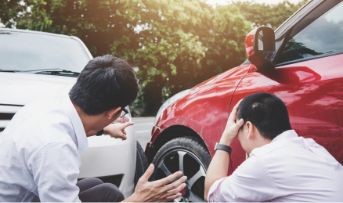
Here's all you need to know about parked car damage and the ways to deal with it
Imagine you park your car in the open and are left surprised when you find it crashed. Parking damage refers to the damage caused to your parked car by an unknown person. You should know what to do if someone hits your parked car.
This article tells you what to do when someone damages your parked car. Additionally, it is advisable to buy car insurance online to protect your vehicle from unexpected damage.
Who pays for parking damages?
If a known person with a liability car insurance policy hits your parked car, their insurance company will pay for your damage. But if a stranger or unknown person hits your car, your car insurance company will pay for the parked car damage.
What should you do when someone hits your parked car?
The first thing you should do is to remain calm and alert when you encounter a parked car damage and follow these tips, including:
1. Find the witness to the accident
If you don't see a driver damaging your car, you should look for witnesses to the accident. Try to find the people who were at the accident spot, and once you find them, ask them about the description or details of the vehicle that damaged your car.
2. Note the offender's details
If you see a vehicle that damages your car, write down its details on paper, such as its registration number, colour, model, etc., and store it safely. You'll have to produce all these details at the police station at the time of filing the FIR and insurance claim.
3. Look for a security camera
Generally, parking spaces and market areas have security cameras installed. You can check who slammed your car and use a copy of the footage to claim your car's damage coverage. However, if the parking space has no cameras, look for nearby residences and shops with security cameras.
4. Capture image proof of the accident spot and your damaged car
Take a picture or video of the accident spots and your damaged car, and procure it as evidence of the accident. Insurance companies will approve your claim based on image proofs.
5. Call the police and file an FIR
Report to the police about your parking car damage, as they can help you find the offender. Moreover, if someone gets injured in a parking car accident, calling the police and filing an FIR becomes mandatory.
6. Inform your car insurer about the accident
Once you follow all the above steps, you should notify your car insurance company about the accident. The company will help you cover your car damage by raising a claim.
What to avoid when someone hits your parked car?
Most people make common mistakes when encountering parking damage. Here are the mistakes you should avoid, including:
1. Chasing the offender
Avoid chasing the driver that hit your car before checking for car damages like leaks, brake failure, etc., or any injuries caused to the person inside the car. Check for injuries and seek medical attention if required.
2. Creating chaos
Most people lose their composure and cause chaos by blaming others around the accident spot. Instead, stay calm and capture pictures or videos of accident spots.
3. Sending car for repair
You should avoid sending the car for repair before filing an FIR and informing the insurance company.
Parked car damage is an upsetting accident, but you have to be patient before you take any steps to deal with it. It is better to wait for the person who hit your car to return and complete the accident report together. If not, follow the above tips to get compensation for the damages to your car from your insurer. Whether you have an expensive or leased car, you should get car insurance online to insure it against parking damage, injury to the driver, and theft.
Click HERE to buy car insurance online.
Disclaimer: The information provided above is for illustrative purposes only. To get more details, please refer to policy wordings and prospectus before purchasing a policy.

The role of general insurance in disaster recovery and mitigation
Natural calamities are very uncertain and the worst nightmare for everyone. In recent years, natural disasters such as earthquakes, floods, cyclones, hurricanes, etc., have been rising globally and scarring the economy and the people. Seeing the destruction and trauma, everyone wants to insure themselves and their assets for financial assistance and mitigations after such an unforeseen and miserable disaster.
While life insurance protects your life and offers financial aid to your loved ones when you are no longer around, general insurance is crucial to reducing the risk of natural disasters and other emergencies. You can insure your assets with general insurance and get assistance to prevent negative economic hardship after a calamity. General insurance can also speed recovery by offering post-disaster liquidity and funding after the disaster.
What role does general insurance play in disaster recovery?
It is a common misunderstanding that natural disasters are rare and one does not need to insure their assets. In recent years, the frequency of earthquakes has been increasing and impacting the whole economy. Home insurance can save you from unpredictable future losses if you live in an earthquake-prone area. The financial losses after natural calamities continue to rise, generating significant financial risk. However, if you have general insurance, it can significantly reduce the financial burden, and you can get a considerable amount to rebuild or recover the property damage.
General insurance safeguards your property and can help you to get immediate assistance from the insurance company to overcome your financial need. The insurance company will reimburse the damages and losses incurred during the disaster and protect you from undesirable situations. Moreover, general insurance not only covers earthquakes but it covers all-natural calamities such as floods, hail, fire, storm, lightning, and hurricane, which cause extensive damage to your home. Thus, it is a worthwhile investment that keeps you financially and mentally sound.
Coverage of general insurance under disaster
General insurance covers the costs of hazards due to unfortunate events for the insured assets. Two types of general insurance covers allow protection against natural disasters: the home insurance policy and motor insurance. Both types of insurance policies are for the protection of assets.
A reliable insurance policy offers recovery for various damages such as damaged electric wires or lines, structure damage, water pipeline damage, broken doors, walls, and physical damage to the vehicle. These insurances cover:
● Exterior damage of the property costs
● Interior damage of the property expenses
● Coverage for physical injuries that may occur during the event while on the damaged property
● Damage or loss of personal assets or belonging from a property
● Cover losses to the vehicle involved in a collision
● Cost for the non-collision physical damage to the vehicle if damages in windshields break, storm, etc.
General insurance policies may vary according to the coverage they offer depending on certain factors and also the coverage you choose. The coverage may differ according to the size, type, location, value, cost of belongings, and age of the property.
Natural disasters are terrifying and cause heavy losses to the affected individuals and their assets. However, a general insurance policy is the right choice to protect your property against such losses. You can easily buy general insurance online in a few minutes without going outside at an affordable price and exciting offers. Browse through different policies, shortlist your options, and after the comparison, you can come to a final decision.
Click HERE to buy general insurance online.
Disclaimer: The information provided above is for illustrative purposes only. To get more details, please refer to policy wordings and prospectus before purchasing a policy.

Unsure of how to maintain your motorcycle helmet shield? Here’s all you need to know
A good helmet is an essential motorcycle accessory for your safety. It protects your head from severe injuries in an accident and can be a lifesaver. The helmet cushioning makes your ride comfortable, especially on a long drive. Moreover, you can also use it to add to your style statement.
A good motorcycle helmet shield is a must feature in a helmet. You should maintain your motorcycle helmet shield to extend the helmet's life and ensure clear vision. Let us discuss how to maintain a motorcycle helmet shield.
1. Cleaning:
The first step to maintaining our motorcycle helmet shield is regularly cleaning it. A dirty shield can obstruct your vision and invite an accident. In most cases, regular glass cleaners can do the job for you. Spray some glass cleaner on the shield, and use a soft and clean cloth to rub the shield's surface. It will remove the dirt from the surface and make your shield spotless.
2. Films and sprays:
Films for helmet shields are easily available at any motorcycle accessories shop. You can customise it according to the size of your helmet shield. It will create a barrier between rain and your shield and help to drip it off quickly. Moreover, you can put a film of any colour of your choice and make your helmet look cool and fancy.
Similarly, several sprays available in the market can be used for the same purpose. Anti-fog sprays are also available, which you can use from the inside of your helmet shield. They do not allow condensation to build up during the cold weather and help in clear vision. Films and sprays also protect your helmet shield from scratches and damage.
Ensure you do not keep your helmet shield up while riding through dusty passages, as it will ruin the effect of anti-fog spray and hamper your vision.
3. Wax:
Buy a good quality wax that can be applied on a helmet shield. Rub it on the surface, and use a soft, clean cloth to add shine to your motorcycle helmet shield. Wax can be effective in adding shine to your helmet shield while protecting it from scratches as well.
4. Keep distance:
Keep some distance from the vehicle in front of you while riding your motorcycle, especially at high speeds. This will ensure you are not bombarded with small stones and dust from their tyres. It will keep your helmet shield safe and secure. It will not crack, nor will scratches appear on its surface.
5. Keep your helmet safe:
Always ensure that your helmet does not fall from wherever you keep it. This applies to both home and outside. Also, avoid keeping it on the seat, mirrors, or handlebar, even if you are away for a few minutes. A fall can break your helmet shield or add scratches to it. Install a helmet hook on your bike and use it to hold your helmet while you are away.
A clean and shining helmet shield is a must while riding a motorcycle. A dirty helmet shield is a big no-no. It can hamper your vision and can cause serious accidents. Moreover, it will spoil your style and looks. When we talk about riding safety, two-wheeler insurance protects you and your motorcycle against damages and accidents, similar to a motorcycle helmet shield. Compare hundreds of options, and buy the two wheeler insurance online that fits your needs and budget. It will provide you with complete protection and financial assistance if your motorcycle is stolen or damaged.
Click HERE to buy two wheeler insurance online.
Disclaimer: The information provided above is for illustrative purposes only. To get more details, please refer to policy wordings and prospectus before purchasing a policy.

The importance of hydration: How much water should you drink?
Staying hydrated is crucial to maintaining good health, but how much water should you drink daily? People often ask this question to ensure they are doing everything to stay healthy and avoid costly medical expenses.
Here, we will explore the importance of hydration and how much water you should drink daily.
How much water should you drink each day?
The amount of water you should drink daily depends on several factors, including age, gender, weight, activity level, and climate. The Institute of Medicine (IOM) recommends that men drink about 3.7 liters (125 ounces) of water per day and women drink about 2.7 liters (91 ounces) of water per day. However, this recommendation includes water from all sources, including food and beverages, not just pure water.
A general rule of thumb is to drink at least eight glasses of water daily, but more is needed for everyone. If you are physically active or live in a hot climate, you may need to drink more water to stay properly hydrated. You may also need to drink more water if you are pregnant or breastfeeding.
Tips for staying hydrated
Staying hydrated doesn't just mean drinking water. It also means consuming foods that contain water, such as fruits and vegetables. Here are some tips for staying hydrated:
● Carry a water bottle with you wherever you go, and sip on it throughout the day
● Drink water before, during, and after exercise to replace fluids lost through sweat
● Eat water-rich foods, such as watermelon, cucumber, and tomatoes
● Avoid sugary drinks, which can actually dehydrate you
● Pay attention to your body's thirst cues; if you're thirsty, drink water
● If you don't like plain water, try adding lemon or cucumber slices for flavour
Importance of hydration for health insurance in India Staying hydrated is essential for good health. Water helps regulate body temperature, lubricate joints, protect organs and tissues, and transport nutrients. It also helps to flush toxins out of the body, which is important for maintaining healthy skin and preventing illness.
For people concerned about health insurance in India, staying hydrated is particularly important. India has a high rate of water-borne diseases, and dehydration can increase the risk of infection. In addition, many health insurance policies do not cover the hospitalisation cost for preventable illnesses, such as those caused by dehydration.
Hydration and health conditions
Staying properly hydrated is important for everyone, but it can be especially crucial for individuals with certain health conditions. Here are a few examples:
1. Kidney disease: People with kidney disease may need to limit their fluid intake to avoid overloading their kidneys. However, it's still important to consume enough fluids to stay hydrated. Sometimes, healthcare providers may recommend a specific daily fluid intake for individuals with kidney disease.
2. Diabetes: People with diabetes may be at higher risk of dehydration due to increased urination caused by high blood sugar levels. Monitoring blood sugar levels and staying properly hydrated can help manage diabetes symptoms and reduce the risk of complications.
3. Heart disease: Certain medications used to treat heart disease can increase urine output and lead to dehydration. It's important to stay hydrated if you're taking these medications, but you should also talk to your healthcare provider about any specific hydration needs.
4. Cancer: Some cancer treatments, such as chemotherapy, can cause dehydration as a side effect. Staying hydrated during cancer treatment can help manage side effects and improve overall well-being.
If you have a health condition affecting your hydration needs, talking to your healthcare provider about staying hydrated is important. They may be able to provide specific recommendations for fluid intake based on your individual needs.
Additionally, certain medications can affect hydration levels, so it's important to talk to your healthcare provider about any medications you're taking and how they may affect your hydration needs. They may recommend adjusting your fluid intake or taking other steps to maintain proper hydration levels.
Staying hydrated is crucial for good health, and drinking enough water daily can be magical. Additionally, for people concerned about their health insurance in India, staying hydrated can help prevent costly hospitalisations caused by dehydration. Following these simple tips, you can stay healthy, hydrated, and happy.
Click HERE to buy robust health insurance in India.
Disclaimer: The information provided above is for illustrative purposes only. To get more details, please refer to policy wordings and prospectus before purchasing a policy.

The pros and cons of travel insurance: Is it worth the investment?
Wanderlust is an exciting feeling to cherish as it blooms the thought of mindful exploration of new places and experiences. Whether visiting with friends, family, or alone, safety matters most alongside enjoyment. And when we talk about safety while travelling, travel insurance is the first step you need to take. Travel insurance covers different areas and uncertainties to help protect you against any financial loss during the trip.
However, many people need to know this insurance and its pros & cons. This article presents you with a complete idea about the same.
What is travel insurance?
Travel insurance covers your belongings against theft or damage and any medical condition arising while travelling. Most travel insurance policies cover lost or stolen luggage, medical emergencies, and trip disruptions. The insurance also covers rental car damage and trip cancellation. When you opt to buy a travel insurance policy, there are different types that you can check. You can buy domestic travel insurance if you are travelling within the country.
Similarly, if you are travelling overseas, get international travel insurance. However, the policy amount varies as per the type of insurance you are purchasing.
Let’s look at some of the pros and cons of travel insurance.
Pros of buying travel insurance
1. It guarantees peace of mind
The main benefit of purchasing travel insurance is the sense of security it provides. Sometimes you worry about any circumstances during the journey and cancel the trip. Even in the worst-case scenario, having travel insurance guarantees peace of mind. With travel insurance, you can focus on making your trip memorable without worrying about the financial stress that might occur due to unavoidable circumstances arising during your trip.
2. Get compensation for lost luggage
In many cases, passengers travelling by air miss their luggage after landing at their destination. Moreover, travellers end up missing their important items during the trip. Missing and lost luggage can be chaotic and hamper your trip excitement. But, with the right travel insurance, you get coverage on phones, cameras, and other essential items. You need to mention all details while claiming the same.
3. Complete medical expense coverage
You cannot predict when you will fall ill or face health issues while travelling. However, because of the abrupt changes in climate, food, and time zone, there is a greater risk of contracting an illness when travelling. You should have a solid strategy to deal with medical issues when travelling overseas because healthcare can be expensive. Once again, travel insurance comes in handy for such a situation. It offers complete coverage for any medical costs incurred due to an illness or accident while travelling. However, it would help if you kept all the medical bills ready while claiming.
Cons of travel insurance
1. It is expensive
If you compare the price of travel insurance with other policies, you will find it relatively high. Also, many people avoid purchasing it since they never feel it is important and necessary.
2. High chance of getting rejected
Your travel insurance claim could be rejected for several reasons. Insurance companies try to bring down the compensation or deny the claim if they find that you don’t have valid or expected proofs and documents to produce. Even if you are claiming for minor injuries, it may get rejected. So, it is best to read all the policies carefully to avoid loss.
Having travel insurance by your side is a worthy investment if bought from the right insurer and by clearly understanding the policy features. If you are looking for travel insurance policies, carefully compare plans of different insurers and invest in the best one. Read the terms and conditions thoroughly and don’t hesitate to ask questions if you aren’t clear about any clause. For additional safety, investing in the best personal accident policy in India alongside a robust travel insurance will help you have a peaceful travelling experience. It’ll ensure you celebrate joyous moments with your loved ones and leave all the worries aside.
Click HERE to buy the best personal accident policy in India.
Disclaimer: The information provided above is for illustrative purposes only. To get more details, please refer to policy wordings and prospectus before purchasing a policy.

What precautions should you take to keep your electronics safe from fire outbreaks at home?
Electronics have become essential to our daily lives, and keeping them safe from fire outbreaks is critical. Numerous things, including broken cords, malfunctioning appliances, and overloaded outlets, can result in electrical fires. Home insurance can provide financial security if a fire breaks out and damages your electronics or other belongings. You can customise your coverage options based on your needs and budget using home insurance online platforms that let you compare multiple policies from various insurance companies.
A fire outbreak might threaten your life and result in significant property damage. Therefore, taking safety precautions to protect your electronics is crucial.
1. Avoid flammable materials
Combustible substances like paper, cloth, and other flammable materials can quickly catch fire and spread. So it's crucial to keep these things away from electronics. Keep your electronics away from draperies, beds, and upholstered furniture. Place your gadgets in a different room and keep them away from combustible objects.
2. Use high-quality extension cords
Use high-quality extension cords that are appropriate for your electronic devices whenever you use them to supply external power. Ensure the cables are in good condition and have the correct voltage and power. Utilising extension cords that are the proper size for your equipment is crucial. Overheating and increased fire danger might result from using too-small cables.
3. Try not to overload electrical outlets
Overloaded electrical outlets are one of the primary causes of electrical fires. If too many devices are plugged in, one outlet or power strip might become overheated and catch fire. Use a surge protector to prevent the overloading of electrical outlets to avoid this. Surge protectors are made to cover any excess voltage and safeguard your equipment from power surges.
4. Inspect and maintain electronics regularly
Regularly check your equipment for signs of wear and tear, like frayed cords or damaged outlets. Replace any outlets or cables that are broken as soon as possible. Cleaning the dust and debris off of your equipment regularly will also help prevent overheating. Internal harm can result from overheating, raising the possibility of a fire.
5. Install smoke detectors
Smoke detectors are essential for quickly spotting fires so you have time to respond and get help. Place smoke detectors in each room of your house, especially the ones that house your electronic devices. To ensure your smoke detectors are operating correctly, examining them frequently is necessary.
6. Unplug electronics when not in use
Always remember to unplug your electronics from the outlets while not in use. Electronics should always be cleared to avoid overheating, which could start a fire. Certain electronics, such as space heaters and irons, if used carelessly, can catch fire quickly.
7. Fires should never be left unattended
Ensure you're constantly watching anything involving a flame or a lot of heat, such as cooking, microwave, etc. Keeping an eye on these electronics will enable you to promptly identify any issues or deviations from the norm. As a result, you might take care of the issue quickly to ensure your family's safety.
Protecting your electronics from fire outbreaks at home is essential to prevent potential damages. Numerous things, including overloaded outlets, damaged cords, etc., can result in electrical fires. A fire outbreak might endanger lives and seriously harm property. Take the above precautions to protect yourself and your home from the adversities of fire due to electronics.
Purchasing home insurance online is an easy and effective approach to safeguard your house and possessions against unforeseen losses or damages. Reviewing the terms and conditions of your home insurance policy is essential before purchasing.
Click HERE to buy home insurance online.
Disclaimer: The information provided above is for illustrative purposes only. To get more details, please refer to policy wordings and prospectus before purchasing a policy.

Electric Vehicle Insurance: Ensuring Safety and Coverage
As the world steers towards sustainable mobility solutions, electric vehicles (EVs) have emerged as a promising answer to the environmental concerns associated with traditional internal combustion engine vehicles. India, too, is making significant strides in the EV market, with the government's commitment to promote electric mobility.
India's ambition to electrify its transportation system is evident in its National Electric Mobility Mission Plan (NEMMP) and Faster Adoption and Manufacturing of Electric Vehicles (FAME) schemes. These initiatives aim to encourage EV adoption by offering incentives, tax breaks, and promoting charging infrastructure development.
As more consumers switch to EVs, the focus on battery technology and its maintenance becomes pivotal after all the battery is at the heart of this technology revolution. And with the growth in this market, there arises a need for a tailored insurance solution as well.
However, many motor insurance companies still do not provide any specialized coverage for EV and HEV batteries, resulting in a void in this fast-developing sector. However, forward-thinking insurance companies are recognizing the opportunity and starting to offer specialized coverage for batteries.
In response to this demand, Magma HDI General Insurance has taken a proactive step by introducing a product: "Battery Secure Add On" This specialized insurance offering is designed to address the unique requirements of electric and hybrid vehicles.
What sets "Battery Secure Add On" apart is its comprehensive coverage of critical EV/HEV components, with a primary focus on the battery. This coverage extends to repair and replacement costs arising from various scenarios. For instance,
• If the battery is damaged as a result of an unexpected power surge while charging or Experiences consequential harm from a short circuit or water ingress, "Battery Secure Add-on” has it covered.
• Moreover, " Battery Secure Add On" goes beyond battery coverage alone. It recognizes that electric vehicles encompass a range of specialized components that differ from traditional combustion-engine vehicles.
• This insurance product also safeguards other electric-specific elements, such as the electric motor, ensuring holistic protection for the entire EV system.
Click HERE to learn more about the product.

Shedding light on Return to Invoice in motor insurance
Most people are familiar with motor insurance, its benefits, and its exclusions. It is an efficient financial instrument that supports us when our insured vehicle encounters an unfortunate incident. Motor insurance comes with many optional coverages that may be useful to you. Did you know about the Return to Invoice or RTI coverage? Choosing this coverage while you buy motor insurance online can be a great help. Let's learn more about RTI coverage, its benefits, and its functionality.
What is "Return to Invoice" in motor insurance?
Return to invoice is an optional coverage for your car insurance. It lets you get money equal to the car's original value, also called the invoice value. This coverage is not required by law, so you can buy motor insurance online and include RTI coverage as an add-on. It is an application you use when your car faces total loss, such as if someone steals it or it gets fully damaged by fire or a natural calamity.
How does it work?
In normal car insurance coverage without an RTI add-on, you can get the maximum claim amount as your car's "insured declared value" (IDV). IDV is always less than the invoice value of the car.
However, with car insurance having RTI coverage, you can get the maximum amount of claim on the invoice value of your car. In simple words, when you have RTI coverage in your car insurance, you can get the road value of your car when it is stolen.
How is it calculated?
You can easily determine the amount of insurance that comes with RTI by looking at the car's total price when you buy it. The return to invoice includes the total car price, such as road tax paid, ex-showroom price, and registration cost.
What is covered in Return to Invoice?
If your car gets stolen or damaged beyond repair, you can raise a claim against the RTI. Let's look at the different circumstances when this coverage can benefit you:
● When you don't have secured parking
● Living in an area where car thefts are common
● Living in an area prone to natural calamities such as floods, landslides, and more
What does not apply in the Return to Invoice?
Sometimes, the RTI cover may not work, and you can't claim the insured amount. Here are some situations when this cover is not applicable, including:
● Damage to your car when someone else is driving
● You can't avail RTI add-on if your car is older than 3 years from the buying time
● You can't avail of the RTI cover for minor dents and grazing on the car body
● You must submit a copy of the FIR to process the return-to-invoice claim
Benefits of Return to Invoice in motor insurance.
Some benefits of RTI in car insurance include:
● It increases the scope of your car insurance coverage
● It is beneficial when you live in an area where car thefts are common
● It is available for new cars. Hence, you can give your new car more care with this cover
● It is available with a comprehensive car insurance policy
Once you understand everything about the Return to Invoice, consider adding this optional cover. RTI can help you when your car is damaged beyond repair. If you live or park your car in a place where theft, natural calamity, or fire is common, you should add RTI to your policy when you buy motor insurance online.
Click HERE to buy motor insurance online.
Disclaimer: The information provided above is for illustrative purposes only. To get more details, please refer to policy wordings and prospectus before purchasing a policy.
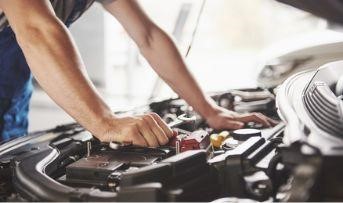
Understanding how a cashless garage facility can be helpful
A cashless garage facility is one in which an insurance company has a tie-up with a garage. Whenever you meet with an accident or file an insurance claim for repairs, you will not have to settle the bill in cash at these garages. The insurance company will directly pay the bill. However, you have to bear some nominal charges for processing the claim. Also, some compulsory deductibles exist as per the insurance policy’s terms and conditions.
Not all garages will have a tie-up with your respective insurance company. The list of network garages is easily available with your insurance company. You need to verify it with your insurance provider and search for the nearest garage that will provide you with a cashless facility. Let us see how a cashless garage facility can be helpful to us.
1. Hassle-free claim settlement:
Insurance companies are directly connected to the network garages. Hence, you do not need to visit multiple garages to complete the repair work. You can directly go to the network garage after informing the insurance company, provide the required documents, and that’s it! The garage will take it over, and the insurance company will settle the bill. The entire claim settlement process becomes hassle-free.
2. Prompt service:
As mentioned above, not all garages are covered in the cashless network list of the insurance company. Hence, listed garages provide prompt and good quality repairs and renewal services to maintain harmonious relations with the insurance company. This can be helpful to you, and you’ll get quick service and timely delivery of your vehicle.
3. No cash payout:
This is one of the most important benefits of a cashless garage facility. In the non-listed garage, you have to settle the entire bill in cash at the time of delivery of the car. Accidents do not come informed. Hence, such sudden bills can put you under a financial burden. The repair costs of modern-day cars are hefty and can cost several thousands of rupees in one go.
A cashless garage facility will release this financial burden from you, and you’ll not have to pay any repair costs from your pocket. Minor documentation and deductibles charges can be easily met. This facility makes the claim settlement process swift, and you do not have to worry about footing the repair bill.
4. Transparent billing and quality service:
The insurance company and its surveyors are in constant touch with the network garage. They provide a big chunk of work to the garage regularly. Hence, the network garages abstain from committing any fraud, using sub-standard components and parts, or engaging in over-billing while repairing cars. Hence, we are assured of fair and transparent billing and top-notch service.
A cashless garage facility is a blessing for all vehicle owners. It makes the claim settlement process convenient, hassle-free, and fast. Also, it relieves us from paying sudden and heavy repairs and renewal charges when our car meets with an accident. We get quality work at reasonable prices.
But first, you need to have a valid and functional motor insurance policy for your vehicle to enjoy a cashless garage facility for it. Always renew your insurance policy on time and never let it expire because accidents do not announce before occurring. Opt for online motor insurance renewal, which makes the renewal process effortless. You can do it from the comfort of your office or home, at any time of day or night. Also, you are saved from the hassle of meeting with the insurance agent or going to the insurance office for renewal. Go the modern way; choose online motor insurance renewal.
Click HERE for hassle-free online motor insurance renewal.
Disclaimer: The information provided above is for illustrative purposes only. To get more details, please refer to policy wordings and prospectus before purchasing a policy.

Did you know about the knock-for-knock agreement in motor insurance
In India, awareness about motor insurance has grown significantly in the last few years. The number of insurance policyholders is slowly but steadily increasing. The increasing means of living and demand for luxury goods to improve convenience are anticipated to keep driving the market for motor insurance. Comprehensive motor insurance consisting of own damages and third-party covers is expected to grow more in the coming future.
Third-party liability insurance is mandatory to protect the driver against legal and accidental liability, financial loss or property damage, and medical expenses he may face after an accident. Despite its advantages, settling claims is a lengthy and costly procedure. The knock-for-knock agreement is a recently introduced aspect of motor insurance to simplify the process and increase the policyholder base and satisfaction.
This blog discusses all you need to know about the knock-for-knock agreement.
The issue before the knock-for-knock agreement:
When an accident happens, the persons involved can contact their insurance companies to compensate the other party for damages. However, this is a lengthy procedure that may sometimes take months to settle with unfavourable conditions. It is also still being determined whether or not the insurer will accept the claim.
In the background of such uncertainties, the affected party has no choice but to file a suit in court, which takes additional time and cost. The knock-for-knock agreement aims to eliminate this waiting period by providing an alternate solution to settle the claim among the parties without the court's involvement.
An alternative approach using a knock-for-knock agreement:
The knock-for-knock agreement is signed by two or more motor insurance companies insuring two or more parties involved in a motor accident. Since these companies are aware of the tedious claim settlement process, they use this alternative agreement and promise to bear the expenses for repairs or damages to their client instead of claiming the amount from the other party. Introduced in 2001 by the General Insurance Council, a motor insurance company doesn't need to sign such an agreement to make the claim process quick.
Advantages of knock-for-knock agreement:
While the concept is simple to understand, here is the summary of the benefits of signing a knock-for-knock agreement:
● Speedy settlement of claims
● Eliminates the need for the involvement of law
● Reduces the expenses required to be borne in case of proving the liability of the third party to derive a settlement from his insurer
Conditions for knock-for-knock agreement:
Three primary conditions are applicable for claims that are admissible under a knock-for-knock agreement.
1. Accidents must occur within geographical boundaries:
The insurance company decides such boundaries before the lodging of the claim. Generally, the limit is considered to be the defined geographical boundaries of India. It is implied that any accident outside the border cannot be admitted as a claim under a knock-for-knock agreement.
2. The claim must be filed as own damages:
Under the agreement, each motor insurance company agrees to compensate its client instead of demanding compensation from the other party. This claim can no longer be filed as third-party damages and is processed as "own damage". Therefore, you must purchase your "own damages" cover, without which you cannot complete this procedure.
3. Limit on the claim amount:
The admissible claim cannot exceed the insured declared value (IDV) previously mentioned in the policy.
The knock-for-knock agreement is a lesser-known aspect of motor insurance that makes claim settlements speedy and inexpensive. It saves the resources of a motor insurance company that agrees to such a contract. Explore this aspect to know more about its seamless benefits before buying motor insurance in India.
Click HERE to buy reliable motor insurance in India.
Disclaimer: The information provided above is for illustrative purposes only. To get more details, please refer to policy wordings and prospectus before purchasing a policy.

Know more about the anti-locking braking system in detail
A critical safety element that is now standard in all modern vehicles is the anti-lock braking system, or ABS. The ABS is frequently marketed as an efficient breaking mechanism that significantly reduces accident risk by facilitating a good grip over the vehicle. We go over everything you need to know about ABS, including its advantages, how it works, and the several kinds you can find in modern vehicles.
What exactly is "anti-lock braking"?
The name of the technology suggests that when you apply the brakes, ABS keeps the wheels from locking. It shortens the distance you need to stop and lets you move or "steer" the car while the brakes are still on. This way, you can avoid collisions from sudden braking and crash into fellow vehicles or objects.
What is the purpose of ABS?
Irrespective of the car's speed, when you press the brake pedal (without ABS), the wheels lock up because the brake pads make tight contact with the wheel discs and stop the wheels from turning.
The car skids because of its momentum when the wheels stop rotating. As a result, the driver has no control over the wheels. Most frequently, this can result in severe accidents.
What are the main components of ABS?
Speed sensors, valves, a pump, and an ECU comprise most ABS parts.
Speed sensors:
These sensors are important to keep track of the wheels' speed.
Valves:
In the brake line, some valves regulate the pressure on the brakes.
Pumps:
When brakes are used, hydraulic fluid-filled pumps pressure the brake callipers or drums.
Electronic Control Unit (ECU):
In response to the signals from the speed sensors, the ECU acts as the command centre of all the processing.
How is ABS used?
When you use the brakes on a car with ABS, the speed sensors track how slowly the wheels turn. Brakes deliver a signal to the electric control unit when they are about to stop rotating. Using valves and pumps, the ECU removes some of the brake pads from the wheels, allowing them to continue spinning. When you apply heavy brakes, ABS enables the wheels to continue turning, giving you control over the car.
Without ABS, when you hit the brakes, the wheels would stop or lock up immediately, causing the car to slide. In this situation, the vehicle would skid and travel a fair distance. It would be challenging to turn your vehicle because the wheels were locked. ABS helps you slow down efficiently, deploy uniform braking, and quickly control your car and avoid it from spinning.
ABS benefits:
● Uneven tyre wear is avoided because the wheels don't lock up when the automobile is stopped.
● The Traction Control System (TCS) and ABS share specific fundamental architectures, which facilitate TCS installation on vehicles in manufacturing facilities.
● You may steer the automobile around obstacles when braking hard, which can reduce brake pad and brake disc wear.
● Minimises the risk of severe accidents due to sudden braking and enhances the car's stability post-braking.
When the brakes are applied hard at high speeds, ABS keeps the wheels from locking up, which makes it much less likely that a deadly accident will happen. The effectiveness of the anti-lock braking system has been demonstrated everywhere. Anti-lock brake systems are now so critical to safety that the Indian government has made them a requirement.
Safety is paramount, and braking is a crucial part of vehicle safety. It's also a good idea to get online motor insurance to upgrade the security of the vehicle and the owner. Motor insurance covers car owners' liabilities and protects them from damage to their cars and any legal obligations they may face. Browse through different options and opt for online motor insurance with the best premium and benefits that suit your needs.
Click HERE to buy online motor insurance.
Disclaimer: The information provided above is for illustrative purposes only. To get more details, please refer to policy wordings and prospectus before purchasing a policy.

These are a few common drainage problems harmful to your house
Most households should foresee drainage issues. We can only hope that the drains in our homes are in good condition because they are out of our sight. But several early indicators alert us to a drainage issue. If left unattended, these drainage concerns put people at risk and give rise to crises like safety, health, and financial problems when dealing with poor drainage conditions.
Seven typical drainage issues have been discovered to guarantee a flawless drainage system by sorting these issues:
1. Even with safety precautions, a clog in the drain system is unavoidable, and people flush many things down into the drain. Although it might begin as a slow-moving drain, it could eventually worsen and end up blocked. It is crucial to try an at-home fix for a blockage as soon as it gets noticed.
2. The installation, regular cleaning, and maintenance of gutters and downspouts are essential for the exteriors of dwellings. Numerous issues have arisen when several people take responsibility for their work independently. Both insufficient pipe installation and a lack of plumbing experience are the leading causes. If pipes aren't put in the right way, they can cause plumbing issues, broken tubes, and other property damage, along with the improper passage of sewage.
3. Drain pipes are subjected to a lot of wear and tear, resulting in fractures or cracks that cause the pipes to have open joints. Water leaks from these cracks could result in serious issues in the neighbourhood and even structural damage. Another indication of leaks and an excess of moisture is the development of mould. Pest infestations that enter through pipeline cracks are another issue about pipe breaking and leakage. Fortunately, one can easily fix these problems with prompt diagnosis.
4. With the right slope, water will flow away from the house. It has a big effect on the slope of the land so that the drainage moves away from buildings, especially in places that need to be paved, like parking lots and driveways. Sometimes, the builder might get this wrong and let water seep in or get stuck in the structure, damaging the walls.
5. The growth of plants can be dangerous to plumbing. In the trenches built around pipes and drains, tree roots can obstruct or destroy pipework as they develop and spread. They can enter the drainage system through openings, mainly already-damaged joints. They usually leave a mess of odours and have significant health risks.
6. Heavy rain or storms and the debris they leave behind can cause clogs, floods, or overflows in the drainage system if not appropriately covered.
7. Flooding can put pressure on pipes and can damage the ground. An inadequate drainage system or pipes is another sign of outdoor flooding.
8. Assume your house is next door to your neighbour's. Even if you take all the proper steps, there is still a chance that water from your neighbours' properties will cause damage to your property. It can occur because of a flood on their land or simply because your property is lower than theirs. To prevent water runoff from the neighbours, you must take the appropriate actions and ask for effective waterproofing of the floor.
These problems show how important it is to keep up with drainage system maintenance to avoid extreme issues. Even though most drainage problems aren't evident at first glance, the above points will help you figure out what's wrong and how to fix it.
Conduct periodic inspections of your house's drainage system and look for damages in the pipes, sinks, or ducts. Immediately call the experts to fix it before the issue becomes severe. Ensure regular cleaning of the drains to avoid clogging and unwanted growth of plants. To deal with other problems related to the well-being of your home, like protection from damages to belongings due to natural calamities and other issues like riots, invest in a reliable home insurance India policy. This will provide you with optimum coverage for your home financial support by compensating for the damages caused.
Click HERE to buy home insurance India.
Disclaimer: The information provided above is for illustrative purposes only. To get more details, please refer to policy wordings and prospectus before purchasing a policy.

Here are a few effective winter travel tips for enjoying a memorable trip
Who does not love to travel in the winter season? The chilly weather with snow-clad mountains or the cool climate on the beaches and plains can be delightful and welcoming. Taking advantage of the pleasant climate and an ideal season to travel, numerous tourists plan family holidays and group tours to explore the best winter destinations in India. But the idea of winter travel reminds us of the arduous task of carrying thick, heavy, woollen clothing.
Are you planning a family trip or a solo adventure this winter? Here are a few effective winter travel tips for enjoying a memorable trip.
1. Plan in advance:
Winter travel in December and January coincides with Christmas and New Year vacations in schools and holidays in offices. Hence, there is usually a lot of crowd at popular vacation spots and heavy bookings on flights, trains, and hotels.
Hence, you should always plan your winter trip well in advance. Book your travel tickets and accommodations as early as possible so that you don’t have to cancel your trip at the last moment due to the unavailability of travel tickets or rooms in good hotels.
Even if you can get flight tickets and good accommodation at the last moment, you will have to pay exorbitant rates. So why not plan in advance, save money and make your trip memorable?
2. Check your flight and train departure:
Always check the timings of your flight or train departure in the winter season before leaving home. They are usually delayed and are sometimes even cancelled due to heavy fog and low visibility. Keep an alternate route or service in mind in case of any cancellations. This will ensure that your travel plan gets successful.
3. Travel light:
You will wonder how we can travel light with bulky woollen clothes, especially if we are visiting some cold place or a hill station. It is possible by following some simple tips. Wear your most bulky jacket, sweater, shrug, or scarf on the day you have to travel. This will mean you will not have to pack them inside your bags. Also, wear your heavy boots and pack your lighter shoes or slip-on in your bag.
Do not pack multiple t-shirts, tops, or jeans with you. Repeat them. What you wear on the top is only visible in winter. Keep changing your jacket, shrug, or coat, and no one will know you are repeating your dresses! Also, buy woollen clothes of superior quality so that you don’t need multiple layers of clothing to keep you warm. Carry thermal innerwear of good quality as they are light and warm.
4. Rent travel gear:
You don’t need to carry your travel gear everywhere you travel in winter. For example, if you want to ski in the snow, you can rent all the essential gear, including snow boots and overcoats, from the resort you are staying in.
5. Medication:
The cold season brings many ailments, such as flu or fever, nasal congestion, cough, etc. Always carry appropriate medication, especially when travelling with kids and the elderly. Also, use small cases for carrying your cold cream and moisturiser so they only take up a little space.
Make your winter trip special and memorable by following the above travel ideas. Another important tip is to go for your true companion that will never leave your side, i.e., travel insurance. Travel insurance will protect you against trip cancellations, lost baggage, damage to your luggage, etc. You can take an annual plan to cover all your trips or insure only a particular trip.
Insurance will also offer coverage in case of any medical emergency and assistance arising during your trip. Make your life secure and tension-free by choosing a wide variety of general insurance policies. Moreover, buy online general insurance from the ease of your home with a few clicks, additional benefits, and the best premium rates. We wish you a happy winter!
Click HERE to buy online general insurance before planning your winter travel trip.
Disclaimer: The information provided above is for illustrative purposes only. To get more details, please refer to policy wordings and prospectus before purchasing a policy.

Smart tips for washing home glass windows with sparkling shine
Have you ever tried running your hand over your house's glass window panes? The amount of dust you will come across is worrisome. We all are familiar with the saying "cleanliness is next to godliness," but at this point, it is not just about keeping your house clean. It is also about your and your family's health. The dust that settles on furniture, doors, and windows surfaces enters your body when you inhale while just being around your house and going about your everyday chores.
Many times, we rush to the doctor with a common cold or some health issue which is related to the hygiene problems arising from the dust and dirt which have made their way into our home, costing us several trips to the emergency room, medicine dosages, or having a troubled sleep at night.
But how can you combat this problem? Don't worry. This blog will discuss smart tips for washing home glass windows with sparkling shine, which would help you eliminate the tiniest speck of dust, leaving the glass panels squeaky clean!
1. Notice the frame:
If you closely examine a window, you will be shocked by the amount of dust, spider webs, etc., settled on the frame of the glass. The first step to cleaning your windows would be to clean the frame so that the dust particles do not float in the air and find their way to any other surface. You can use a microfibre towel to clean the dust and a sparkling shine solution to wipe off the frame after dusting.
2. How about a mop:
The windows can be large and high, which might not be accessible to clean using a small microfibre towel. A mop with a stretchable handle is the best idea in this scenario. You can dip the mop in a solution, wring it and then wipe the glass windows by stretching the handle to the required length. Ensure that the mop reaches all the corners of the windows, thus giving them the sparkling shine!
3. A small wiper is an intelligent option:
Doubling up on cleaning supplies has never gone to waste. Apart from using a microfibre towel and a mop, you can also use a small wiper which would help you wipe off the cleaning liquid so that it doesn't leave a stain on the window. Keeping a wiper will help you clean the window's exterior glass panel, thus eliminating pollen or bird waste, etc.
4. Rain can be difficult for the windows:
It is advised to clean the windows from the inside and the outside three to four times a year. The most favourable time to clean your windows is during spring and autumn. Cleaning your windows during these seasons helps eliminate any complicated to-clean mineral deposits that might have been set due to the rains.
5. Cleaning directions are a huge bonus:
Spraying some cleaning liquid and using a microfibre towel to wipe the windows can have magnified effects if you clean the window in a circular motion and jazz it up by swiping horizontally and vertically to avoid setting off any liquid stains or dirt.
Other tips include using tongs when cleaning window panes and blinds, using a lint roller on the window screens to remove the lint that might have found its way, cleaning/vacuuming the curtains, etc.
These were a few smart tips for washing home glass windows with sparkling shine. Keeping your house clean and hygienic is very important. Home is not just a place to live; it is an emotion. It houses millions of memories and fosters relationships, so you must get home insurance to protect this sacred space against any unforeseeable mishaps and situations. You can look for the benefits of the various home insurance options which are available in the market and purchase the one which suits your needs.
Click HERE to learn more about buying home insurance.
Disclaimer: The information provided above is for illustrative purposes only. To get more details, please refer to policy wordings and prospectus before purchasing a policy.
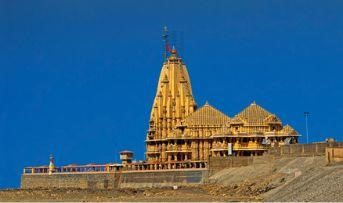
List of ancient temples in India that you must visit once in your lifetime
Out of 195 countries, setting oneself apart from others is difficult. Most countries are either known for their rich resource endowment or their progress and economic significance. Over the years, India has continuously made optimal use of its resources to cultivate its financial position amongst other leading developing and developed countries. However, one thing that makes India genuinely unique is its rich cultural identity.
India is a land of deep-rooted culture and traditions. Ancient temples and practices are proof of the long legacy of the old civilizations that formed the fundamentals of society. There are over two million temples in India, proving the significance of heritage and spiritualism in the country. Of this enormous number, many temples have existed since the rule of the ancient kingdoms and are proof of the vibrant traditions and beliefs of Indians.
The easiest way to experience the diverse culture of the expansive land is by immersing in the historical archives engraved on the temple walls and sculptures. Before you plan your trip to explore these temples, we recommend contacting a general insurance company to purchase a comprehensive cover to compensate for any damages during travel. After checking that off, here is a list of ancient temples you must visit!
1. Mundeshwari Devi Temple:
Located in Bihar, it is said to be one of the oldest temples in the country, open to the public. The Archaeological Survey of India dates the temple back to 108 AD after consideration of its design and architecture. The temple is a shrine for Lord Shiva and Goddess Durga and is popularly known for its distinct octagonal design.
2. Somnath Temple:
Located in Gujarat, the Somnath Temple worships Lord Shiva. It is one among the 12 Jyotirlingas and holds great significance to the devotees of Shiva. The legend behind the temple also involves the Moon God. The temple initially held massive troves of treasures, which Mahmud of Ghazni raided during his attacks. Despite being destroyed, the temple has been restored and provides a peaceful environment to bask in its cultural significance.
3. Sree Padmanabhaswamy temple:
The gold-plated temple in Kerala is dedicated to Lord Padmanabha. Also known as the richest temple in India, the temple is thought to have existed for over 5000 years. The temple's wealth is estimated to be around 1 Lakh Crore Rupees, excluding a closed vault that cannot be opened until the chanting of the Garuda Mantra, an unknown chant.
4. Konark Temple:
The temple, built in the 13th century, is a UNESCO World Heritage site in Orissa. Dedicated to the Sun God, its architecture sets it apart from other temples. It is designed based on geometric ideals, making it truly unique. The main temple had a suspended sun idol built using granite and magnets.
5. Dilwara Temple:
Dilwara Temple is an important Jain pilgrimage in Mount Abu built between the 11th and 13th centuries with intricate engravings. The exterior does not give insight into the grandeur of the exquisite marble carvings inside. The hilly terrain outside makes one appreciate the entire process of building the temple in an age without the convenience of transport vehicles.
6. Amarnath Cave Temple:
Situated in Jammu and Kashmir at a height of 3900 metres, visiting this shrine is an experience like no other. It is a naturally formed cave with a lingam of ice resembling Shiva's idol. Reaching the temple is challenging and requires significant effort and dedication.
While it is recommended to visit such divine places to uncover and understand the traditions and Indian heritage, it is also essential to pay heed to one's safety during the travel. A general insurance company provides excellent travel protection that one must consider before planning a trip.
Click HERE to buy travel insurance from the best general insurance company.
Disclaimer: The information provided above is for illustrative purposes only. To get more details, please refer to policy wordings and prospectus before purchasing a policy.

Here are the best blue water beaches in India which should be on your wishlist
Who does not enjoy travelling? Being able to visit and explore new places, try local cuisine, click pictures, and enjoy the native culture of a place is the dream of every traveller. Travelling fills the heart and mind with a sense of euphoria. It boosts your happy hormones and uplifts your spirits. Hence, everyone must take at least one vacation every year.
What if you're a beach person looking for your next blue water beach holiday in India? This article is just for you. We recommend 05 top beach holidays where you can enjoy quality time in blue waters and golden sands.
However, no matter where you travel to, you should always have general insurance to back you up. You can check the general insurance online quote in advance and purchase insurance that provides comprehensive coverage for your luggage and ensures a safe trip.
Here's a list of the best blue water beaches in India.
1. Marari Beach, Kerala:
If you're a fan of Kerala, you should visit this beach. Located near Kochi, this beach is close to the Mararikulam village of Kerala. The waters are apparent here. It is also peaceful and full of lush green vegetation around the village. It is also rated among the top five hammock beaches in India. You can spend some quality time here with your loved ones.
2. Butterfly Beach, Goa:
Present in South Goa, you can reach this beach easily by taking a ferry ride from Agonda beach. It is one of Goa's hidden gems, unexplored by most travellers. Not many people are aware of the magnificence of this beach. It is picturesque and beautiful in every possible way. It is a haven for nature lovers. Many butterflies hover over the beach, making it all the more enticing.
3. Radhanagar Beach, Andaman and Nicobar Islands:
It is one of the most picturesque beaches on Andaman and Nicobar’s Havelock Island. It has clear blue waters and white sands to its credit. A line of coconut trees surrounds the coastline, making it all the more aesthetic. The sunsets here are a sight to behold. You also have the chance to participate in various water sports when you are here at the beach.
4. Varkala Beach, Kerala:
Also known as Papanasam Beach, Varkala beach is one of the most breathtaking beaches in Kerala. You will catch a stunning view of the Arabian Sea from the cliffs present at the beach. You can either sunbathe on the golden sands or stroll by the coast. This beach is serene yet beautiful. You can also go swimming in the waters and rejuvenate yourself.
5. Bangaram Beach, Lakshadweep:
With its jaw-dropping blue waters and white sands, this beach is a cheerful retreat to enjoy with close ones. It is secluded from the hustle and bustle of city life. The beach has brown rocks on all sides. It makes the beach all the more attractive. The beach also has unique bioluminescence at night. The blue waters glow and look starry.
Make these top beaches a part of your travel bucket list and plan a dreamy holiday to savour these destinations' mystic charm. Regardless of the places you want to travel to, always have general insurance to keep your travel covered. An ideal insurance policy will cover your expenses if you incur any damages while travelling or if your luggage is damaged or stolen. You should also check the general insurance online quote before you apply for any policy. Research the best options and invest in a plan that best suits your needs. Better be safe than sorry!
Click HERE to get a general insurance online quote.
Disclaimer: The information provided above is for illustrative purposes only. To get more details, please refer to policy wordings and prospectus before purchasing a policy.

Enlisting the simple yet effective soundproofing solution for your room
We all want to live and work in a peaceful environment that motivates us to always give our best. Silence boosts productivity and makes the surroundings blissful. Silence is required for various activities throughout the day. Whether studying, working, or even sleeping, loud noise can disrupt your peace and well-being. High levels of sound have many ill effects on an individual's physical and mental health.
Significant decibels of sound not only lead to noise pollution but also contribute to an unbalanced lifestyle. It can increase blood pressure and heartbeat. It is also highly harmful to kids and older adults. Increased exposure to noise can damage the eardrums in the long run. It also increases anxiety, frustration, and irritation and can even trigger migraines and anxiety attacks.
The simple way to tackle this problem lies in soundproofing. It is a great boon to humanity and helps in preventing unnecessary sounds. Everything can be blocked by using soundproofing at home, from construction noises to vehicle horns.
Before making any changes to your house, purchasing the best house insurance India is recommended to safeguard your home in emergencies.
Without further ado, let's have a look at the best tips and tricks for soundproofing quickly at home.
1. Make use of soft materials or fabrics:
It is a known fact that sound travels via waves. This means that hard materials like metals amplify the sound. The more iron, tin, or copper you have around, the more complex sound will travel through them. On the other hand, soft materials like linens, cotton, and silk absorb sounds. The more soft fabric you have in a room, the better. Your curtains, carpets, blankets, and rugs can contribute a great deal to absorbing sound. You can also invest in soundproof curtains.
2. Use acoustic frames:
It is one of the latest things available for absorbing sounds. They are wooden frames with foam intact in them. They are highly efficient in absorbing sounds. They can be hung on the walls for soundproofing. This also prevents the noise of adjacent rooms from entering the desired room. It is excellent for people who live in apartments or condos. Acoustic frames are available in various shapes and sizes as well.
3. Consider adding layers:
If your building is still in development or if you have access to renovations, consider adding a layer of drywall. This wall will separate your room from the outside world. It will also cut off all external noises and prevent them from reaching your room. The stronger the wall, the better. It is advisable to get it done with the help of professionals while building a new room.
4. Notice the doors:
The doors play an integral role in determining the amount of sound that enters the room. For starters, keep it closed at all times. You can consider adding weather stripping around the door knob or handle. This will prevent any unnecessary noise from entering or leaving the room. You can also make use of a soundproof blanket. It can be put at the back of your door and removed when not needed.
5. Pay attention to the floors:
Floors can also help in soundproofing. You can put carpets on the floor to absorb the noise from outside. If you want a more effective solution, you should use foam flooring. It can be easily added over the flooring present and does not require much effort for installation.
These are some great ways to prevent noise from entering your house. Implement these and reward yourself with a peaceful and soundproof environment. In addition, protect your home with the best house insurance India, as it helps you deal with financial expenses in case of mishaps.
Click HERE to buy the best house insurance India.
Disclaimer: The information provided above is for illustrative purposes only. To get more details, please refer to policy wordings and prospectus before purchasing a policy.

Tech may not be the best solution to expand the Indian policyholder base
Even though the Indian insurance market has been expanding quickly in recent years, just about 3% of Indians currently have life insurance. Increasing the base of policyholders is essential to ensure that more people are sheltered from financial shocks. Although technology has been suggested as the answer to this issue, it may not be the most effective strategy to increase the number of Indian policyholders. This blog will discuss how tech may not be the best solution to expand the Indian policyholder base. So, without any further delay, let's get started.
1. Accessibility is still an issue:
As it is frequently out of range for significant portions of the population, technology may not be the most incredible way to increase the number of Indian policyholders. Despite India's tremendous internet expansion, many residents of rural areas still need access to smartphones and the internet.
The most successful way to communicate with these people is still through conventional media like newspapers, radio, and television. There is a substantial digital divide between tech adepts and those who are not. For instance, older individuals may need help navigating online insurance platforms, and individuals who do not speak English well may need help understanding the language used in many online insurance policies.
2. Price is one of the primary reasons:
Technology can be expensive to develop and maintain, which is another reason why there might be better ways to increase the number of policyholders. For smaller insurance companies, it might be too expensive to spend on technology, software development, and cybersecurity to build and manage online insurance platforms.
Insurance companies might also need to engage specialised personnel to operate the platforms, raising expenses even more. When costs like these are eventually passed on to customers through higher premiums, insurance becomes less affordable and less available to those who need it.
3. Lack of trust and belief in the insurance providers:
Additionally, there may be better uses of technology than fostering public confidence in insurance. Many individuals in India continue to be cautious of insurance companies and doubt their motives. This distrust is frequently based on prior instances where insurance companies have allegedly broken their commitments or failed to live up to their pledges. Personal interactions, open communication, and moral conduct are necessary for fostering trust and confidence in the insurance industry. Technology can undoubtedly make some of these encounters easier, but it cannot replace the value of human interaction, especially when fostering trust.
4. Absence of proper awareness and information:
Since technology tends to overlook the significance of insurance education, there might be better answers. Educating the public about the advantages and importance of life insurance is essential to increase the number of policyholders. Understanding the many insurance policy types, the coverage they provide, and how to pick the one that best suits their needs can all be achieved with insurance education.
The value of in-person interactions with trained insurance agents who can answer questions, offer guidance and help people choose the best policy cannot be replaced by technology, even though it can help deliver this education through online tutorials, webinars, and other digital resources.
What could be some probable solutions to this issue?
Policymakers may concentrate on enhancing life insurance education and awareness initiatives, particularly in rural areas. Offering financial incentives to those who buy insurance policies, including tax savings, may encourage people to enrol in insurance. Insurance companies may also consider partnering with banks, post offices, or non-governmental groups to reach a larger audience as an additional distribution channel.
We hope this blog provides insights into this issue and how insurance companies can grow their consumer base. While we are on the topic, it only seems like a brilliant idea to talk about how you need to get insurance from the best general insurance company which caters to its customers' needs optimally and is available 24*7 to assist them with their queries, therefore, helping them arrive at a decision.
Click HERE to learn more about how you can choose the best general insurance company for your needs.
Disclaimer: The information provided above is for illustrative purposes only. To get more details, please refer to policy wordings and prospectus before purchasing a policy.

Taking insurance on your education loan may help you financially secure yourself
Higher education costs increase yearly, and many students turn to education loans to fund their studies. While a student loan can be a great option to finance your education, it can also be a significant financial burden after graduation. That is why it is crucial to consider taking out insurance on your education loan.
General insurance plans can offer you financial security in case of unexpected events that may cause you to default on the repayment of your education loan. Let's examine the benefits of taking out insurance on your education loan.
1. Financial protection for unforeseen events with education loan insurance:
Firstly, it provides financial protection to you and your family in case of an unexpected event such as job loss or a medical emergency. Suppose you cannot repay your education loan due to unforeseen circumstances. In that case, the burden of repayment falls upon the co-applicants. If you purchase insurance coverage, your insurer will ensure that your loan payments are taken care of, providing much-needed relief to you and your family during difficult times.
2. Improving credit scores with education loan insurance:
Insurance on your education loan may also improve your credit score. If you default on your education loan, it can adversely impact your credit score, making it more difficult for you to obtain credit in the future. By taking out insurance, you can avoid defaulting on your loan. This will help you maintain a good credit score and ensure that you are in a better position to obtain credit in the future.
3. Reduced burden of repayment:
Thirdly, insurance on your education loan can provide peace of mind. It can be stressful to think about the financial burden of repaying your education loan, especially if you are doubtful about your future income prospects. With insurance coverage, you can rest assured that your loan payments are taken care of. This will help you focus on your studies and career prospects without worrying about loan repayments.
4. Inbuilt insurance in education loans:
Insurance on your education loan may only sometimes be necessary. You can manage your loan repayments without insurance if you have a stable income and a good credit score. Additionally, some education loan providers may include insurance coverage as part of their loan package, so check with your loan provider before taking out a separate insurance policy.
Another critical factor to consider when buying insurance on your education loan is the type of insurance policy you choose. Various insurance policies are available, such as disability, unemployment insurance, etc.
5. Unemployment insurance for education loans:
Unemployment insurance can provide temporary financial assistance if you lose your job and cannot repay loans. It guarantees repayment of the loan amount without letting it reflect as a default. It also allows you to focus on finding stability and a consistent source of income rather than worry over the possibility of defaulting payments.
In conclusion, general insurance plans on your education loan can provide valuable financial protection and peace of mind. Similar to purchasing other general insurance plans, assessing your individual needs and circumstances is essential when choosing an insurance policy for your education loan. Carefully review the terms and conditions of the policy, and compare policies to ensure that you are getting the best value for your money.
Purchasing general insurance plans for your student loan is not necessary and only mandatory when applying for institutions abroad. It can be a valuable tool for all those who want to protect themselves and their families from unexpected events that may affect their ability to repay their education loans.
Click HERE to buy different general insurance plans online.
Disclaimer: The information provided above is for illustrative purposes only. To get more details, please refer to policy wordings and prospectus before purchasing a policy.

These tips will save you from stressing on your daily long-distance commute
As the pandemic's effects subside and we return to offices, the stress associated with commuting has returned. Every weekday, most office workers face a huge challenge in the morning of whether travelling upwards of an hour one-way is worth their compensation.
Whether you choose private or public modes of transport, here are some tips and tricks to relieve stress from your daily commute.
1. Prepare the night before and leave earlier:
Hectic mornings increase stress levels during the commute, which results in irritation and reduced productivity. Worrying about being late every day can be very stress-inducing. To combat this, start preparing for your day ahead at night. Keep your work clothes and meals ready, and finish all your work. This will lead to a less stressful morning, resulting in you leaving 10 minutes earlier and not worrying about delays in reaching.
2. Try to commute actively:
Commuting via personal transport, such as a car or bike, can cause health issues. The best way to go about this is to walk or cycle as part of your commute if your work location is not far. This is known as an active commute, and it will drastically change the way you travel. Exercising on your way to work releases endorphins and improves mental and physical health. If walking or biking is not possible, try to take public transport. It increases your activity and reduces stress levels significantly.
3. Detach from the digital world:
In the age of social media, it is increasingly challenging to focus on oneself rather than what people on the internet are doing. It is essential to go off the grid for your mental health.
Your daily commute could be your time to read a new book, watch the view outside, or focus on yourself with meditation. Meditation has been a proven method of giving the brain the rest it deserves, and whether it be guided meditation or simply focusing inward, it will surely benefit you.
4. Try getting flexible hours:
It makes absolutely no sense sometimes that everyone has the same office hours. This causes the "rush hour," which is impossible to tolerate five days a week. If this is an option, ask your office for flexible hours, so you can come in before the rush hour and leave earlier too.
If this is not an option in your company, find some activities around your workplace before leaving for the day, like working out or reading a book in a nearby park. This way, you'll be able to avoid rush hour.
5. Try to buddy up for a long commute:
If you find driving incredibly dull and tedious, one way to improve it is to find neighbours who go to the same area for work and carpool with them. This way, the pressure of driving does not fall on you every single day, and you can chat with people along the journey. Ensure that you purchase new motor insurance or avail of online motor insurance renewal facilities to protect yourself and your car against the financial burden of accidents.
6. Stretch it out:
Keep stretching those aching muscles! Even when you're the one driving, always keep adjusting your neck and back, so they don't cramp up and give you further pain.
In conclusion, since long-distance commutes are an inescapable necessity in the urban lifestyle, effective management techniques are becoming essential to prevent strain on your mood and physical well-being. We recommend alternative commute methods to private transport for the best impact on your health. However, in case of no option but to travel by vehicle, ensure that you protect yourself against accidents. Check for your insurance status and get online motor insurance renewal before the due date.
Click HERE to know more about online motor insurance renewal.
Disclaimer: The information provided above is for illustrative purposes only. To get more details, please refer to policy wordings and prospectus before purchasing a policy.

These tips can change the outcome of your DIY house painting project
Buying a house can be an expensive but gratifying event. It is an extensive process involving multiple options and intense decision-making to create your dream house. After spending massive amounts of money, effort, and resources on your home, investing in house insurance India is prudent to protect your home, belongings, and more from uncertainties.
After spending massive amounts on purchasing your home, consider these DIY for your home's interiors to save on additional expenses. Equipped with the right tools, creativity, and zeal, you can take on any home DIY project! A painting project is the ideal task to test your skills and is manageable. Before you start painting, here are some tips to enhance the outcome of your DIY house painting project.
1. Purchase premium paint:
Make sure to pay attention to the quality of the paint. Every room in your house deserves a different type of paint, so keep that in mind. Choose paints with minimal volatile organic compounds and odour to keep your family safe. For your favourite walls in your house, choose a standout colour to create an accent wall.
2. Remove the hardware:
Remove light fittings, doorknobs, electrical cover plates, window locks, and window lifts. Store the components in a bucket. Tape the screws to each piece of hardware, and identify each one with its location to simplify future reinstallations.
3. Identify the type of paint on existing walls:
Test a patch to determine what colour was used there. Apply alcohol-soaked cotton to a small section of the wall. The paint is latex if there is paint residue on the cotton ball. If not, the colour is oil-based.
4. Inspect and prepare the area:
Before applying new primer and paint, check for any cracked or peeling areas. These need to be carefully sanded or scraped, as the weight of the new layer will loosen the old paint. A small amount of soap and water, followed by a rinse with clean water, may be required for greasy stains, followed by a wipe-down.
5. Paint from top to bottom:
Use your brush to start with the edges of the ceiling. Then use the roller to apply an even paint coating from top to bottom. Once you're done with a patch of the wall, leave it to dry. Continue the same process for the remaining patch of the wall. You might notice colour marks and streaks on the already-done patch. Now, get ready for the second round of coating. Ensure that your application motion is the same as the first round of coating to get a bright and evenly looking finish.
6. Fill in fractures, voids, and holes:
Examine the walls and trim carefully for flaws. Fix any holes, dents, and dings with wood filler, caulk gun, or ready-mix spackle, depending on the situation.
7. Safeguard everything you don't want to be painted:
Protect your flooring, furniture, and hardware before starting a painting project. Drop clothes are essential. Protecting door knobs with small plastic sandwich bags is a simple solution.
8. Use a paint grid:
A paint grid is an attachment to the bucket's rim. It facilitates the removal of extra paint and uniformly distributes it across the roller cover for consistent paint application.
9. Apply primer:
Paint and primer combinations work well if the surface is clean and smooth. However, use a different primer if it has been over eight years since the last paint job or if the wall has dents and scratches. Use a bonding primer to cover a hard surface, such as glass or high-gloss paint.
Interior painting projects require time, effort, and skill. While you can take on this task by yourself, the same does not apply to protecting your home. Consider purchasing house insurance India to protect your home against irreparable damage and prevent the depletion of your finances.
Click HERE to buy the best house insurance India.
Disclaimer: The information provided above is for illustrative purposes only. To get more details, please refer to policy wordings and prospectus before purchasing a policy.

Considering installing a solar panel rooftop? Here’s all you need to know
When switching to a sustainable energy source like solar, it is wise to conduct a careful study because this is an expensive purchase you will have to live with for 25 years. In this post, we will provide essential questions so you can learn everything you need to know before installing solar panels on your home. These solutions will simplify your solar journey.
1. How much can solar power reduce your household electricity costs?
The monthly savings from solar for household electricity users can be as much as 80%, and in certain circumstances, even more. Before ordering a solar system, determine how much money you will save.
2. Can you utilise net metering at your house? When should you apply if the answer is yes?
Savings from solar can be maximised using a net metering feature in conjunction with an on-grid or hybrid solar system. In exchange for payment, you can export the extra electricity your solar system produces to the grid.
Now, homeowners in all of India's states can use the facility. However, the advantages may vary based on the tariffs established by the individual states. Before and after your solar PV system installation, you can apply for net metering. Nonetheless, we advise you to apply for net metering before the system is installed for your convenience.
3. How much would it cost for your rooftop solar system?
Over the past ten years, solar system prices have decreased significantly. A typical 1 kilowatt (kW) solar system, which cost about INR 145 per watt (Wp) in 2000, is now available for about INR 35 per Wp. However, the final price varies according to the project's size, the skill level of the solar installer, and component quality.
Residential solar systems are often smaller than commercial or industrial ones, and because of the smaller scale of operations, the cost per KW tends to be more significant. The essential thing in this situation is not to hold back on the components' quality or the installer's knowledge.
4. When will your solar system reach financial stability?
With a properly installed household solar system, you should reach your breakeven point in about three and a half years. However, the system size and the state's DISCOM tariff rate affect the breakeven point. The critical thing to remember is that since solar energy returns come in the form of savings, they are guaranteed. You can use a solar calculator to determine your expected payback period and return on investment.
5. Is the rooftop of your house a suitable location for solar panel installation?
It is crucial to examine the capacity of your rooftop. Your rooftop needs to support the combined weight of the mounting structures and the panels. A rooftop must be free of any shadows cast by surrounding structures or objects because most homes in India are constructed too close to one another.
6. Are there any tax benefits for your residential solar investment?
Household electricity is not currently eligible for any tax incentives. However, the investment is worthwhile, though, because the savings on electricity bills alone are substantial.
After investing in such sophisticated technologies and energy sources, it becomes crucial to protect your home against any unforeseen contingencies. In such cases, the best home insurance in India can also assist you in significantly reducing your financial outlay by protecting your home, its structure, and content from unexpected loss or damages.
Click HERE to buy the best home insurance in India.
Disclaimer: The information provided above is for illustrative purposes only. To get more details, please refer to policy wordings and prospectus before purchasing a policy.

Collisions: Types and how to avoid them
Accidents, unfortunately, happen far too frequently. They cause vehicle owners to pay for auto repairs, treating injuries, and increased insurance premiums when accidents occur. A small error might lead your car to be totaled in an instant. Purchasing a policy from a reliable motor insurance company in India secures you and your vehicle from various hazards and damages that could cause financial losses.
We repeatedly observe the same trends that lead to collision incidents. To decode this most common issue, we're presenting the most typical crash types and accident-prevention advice to make the roads safer.
1. Front-impact collisions:
When the front of your vehicle collides with another car or object, it is called a front-impact accident, accounting for 54% of all auto accidents. It can result from wrong-lane driving or a poor indication by the approaching vehicle from the front, especially while making turns.
How to avoid them:
Modify your driving according to the circumstances, such as slick roads or other weather-related issues. Give yourself more time to react and take control by driving more slowly in the rain and using indicators while taking turns. Keep your focus on the road and avoid any distractions.
2. Rear-end collisions:
Heavy commuter traffic on roads and thoroughfares, over-speeding, aggressive driving, and leaving insufficient room for the car in front of you are the common causes of rear-end collisions.
How to avoid them:
Driver distraction accounts for 89% of rear-end collisions. Avoid being distracted by putting the phone down, even in driving mode, and adjusting your audio. Additionally, stay aware of your surroundings and avoid tailgating by not maintaining a safe distance from the vehicle in front.
3. Parked-car collisions:
In crowded parking lots, bumper dents are all too typical. They occur when several vehicles travel in various directions or while reversing out of a parking space.
How to avoid them:
Parking lots can make viewing your surroundings challenging, especially when reversing. Before leaving a parking space, survey the area and use your rear-view mirror effectively. Park a bit further away from other vehicles.
4. Side-impact collisions:
Side impacts between cars travelling in different lanes parallel to one another are the norm in cases of sideswipes. This kind of accident accounts for 27% of fatal passenger crashes.
How to avoid them:
Refrain from speeding to beat the yellow light. Instead, be extra cautious and always check both ways at stop signs and traffic lights. Check your blind spot before changing lanes, and watch for sudden lane changes from other motorists.
5. Hydroplaning collisions:
Since the tyres can't touch the pavement when you hydroplane, you have little control over the direction of the automobile, which almost definitely results in a collision. More than 10% of car fatalities yearly are related to wet roadways.
How to avoid them:
Stop accelerating, and don't stamp your foot on the brakes if your car does hydroplane. Instead, keep the pressure constant and let the automobile slow down. Make sure the tread on your tyres isn't too worn out. When driving through significant road puddles, proceed slowly.
Although there are many steps you may take to lessen the risk of accidents, theft, injuries, or damage to your car, it's not always possible to avoid the unexpected. In road accidents, collisions are a significant factor in injury and fatalities. We recommend purchasing a comprehensive auto insurance policy from a trusted motor insurance company in India. This will protect you and your vehicle against various damages and provide monetary compensation for expenses resulting from theft, fire, natural disasters, third-party liabilities, accidents, and other tragedies.
Click HERE to learn more about the policies offered by the best motor insurance company in India.
Disclaimer: The information provided above is for illustrative purposes only. To get more details, please refer to policy wordings and prospectus before purchasing a policy.

A clutter-free home is not a distant dream with our simplified guide
After purchasing your home, maintaining and protecting it becomes the highest-ranked priority. Keeping a clutter-free home helps you bring positivity and a better sense of well-being. While buying the best home insurance policy in India can help shift the burden of contingencies like burglary, vandalism, etc., how do we safeguard our homes from habits like hoarding and stockpiling?
If you find it challenging to keep your home clutter-free, here is a short guide to maintaining and optimising your space.
1. Identify clutter:
Our physical, mental, and emotional lives can become cluttered with irrelevant items. But what appears to be clutter may be an extraordinary item for you. Physical clutter usually occurs when we have too much stuff and no orderly mechanisms to store them. Owning less stuff makes your home clutter-free and more accessible. Having less material also positively affects our time, lives, and energy.
2. Get rid of the extra:
Eliminating the surplus items that consume our lives, time, and energy is the first step in keeping your home clutter-free. Clutter can be described as having too much stuff in a limited space, resulting in a disorganised home. Slowly navigate from room to room while using this filter to weed out items that are not required.
3. Avoid acquiring too many possessions:
Clutter can be efficiently managed by effective space management. You need to understand that the goods cost more than what is listed as their final retail price. We must alter our perspective and assess our purchases differently to stop the accumulation of goods in our houses. Start by asking yourself these questions before making a purchase –
● When I get it home, will there be a place to store it?
● Exactly why am I purchasing it?
● What value does it bring to our home and well-being?
4. Establish routines to manage your clutter:
Finding and creating routines to effectively manage your belongings will be the easiest way to remove the surplus. After removing the excess, it will be easier to identify the practices that keep your living environment clutter-free. Also, you'll find it simpler to adopt these habits once you've experienced the independence and stress-free lifestyle that comes with living clutter-free.
Clutter draws more clutter, and it needs to be eliminated. Create healthy habits for your family to control how your home's possessions are used regularly. They will be simpler to apply once you've identified them.
5. Plan decluttering maintenance times:
The most crucial step is to make a timetable and follow it. You can do this daily, weekly, monthly, quarterly, or seasonal. Remember, you need to declutter and organise regularly.
You'll feel better about your clutter-free home if you're disciplined about following through with your maintenance program. The more time passes between your regular sessions, the more you'll notice that your house could be cleaner and more orderly.
Building habits around clearing up excess clutter should be prioritised in your daily routine. The critical components to living in a clutter-free environment are recognising and knowing what to do with it and having the discipline to carry it through.
The beautiful thing about decluttering your house is that your efforts will have a long-lasting good impact on your sense of self-worth and how you regard your living space. While this will help protect the area inside your home and make better choices as per your tastes, buying the best home insurance policy in India provides the safety of external protection for your house.
Click HERE to buy the best home insurance policy in India.
Disclaimer: The information provided above is for illustrative purposes only. To get more details, please refer to policy wordings and prospectus before purchasing a policy.

Here are some tips to improve your home’s appeal in minutes
The first impression your house has on the visitors can be everlasting as they leave. It is a huge deal to keep your home tidy, chic, and beautiful. It can make you garner a lot of accolades from your fellow friends and family members.
However, the whole process can be tedious as the remodelling or redesigning can take time and effort. What if we tell you that you can make your house look appealing in a few hours? As shocking as it may sound, we have curated a list of the best ways to spice up your home’s aesthetic appeal. These ways are innovative, easy, and do not require much time or money.
Also, your house has a high perceived value and should be well protected. Hence, you must consider purchasing home insurance to keep your home and belongings safe from contingent events like burglary, vandalism, natural calamities, property destruction, etc.
However, if you are planning to make your home look better and more appealing to the guests or want to refresh the look of your home as per changing trends or your taste, then take a closer look at the following points.
1. Make your lighting better:
Lighting can make a big difference to your home appeal. You must have bright, chic, and charismatic lighting around your house. You can also spice up your bedroom lights by adding a touch of fairy lights or mood lighting. An addition of golden-hued lights to the dining area and living room adds to the ambiance.
2. Conceal the garbage bags and dustbins:
Nobody likes to see trash lying around in their homes. It can create a terrible impression on your visitors. When guests come over, you must thoroughly scan your house and conceal your garbage bags. Put them in a place that is not easily visible to your guests. A permanent solution could be to switch up your interiors to create a covered dustbin storage section.
3. Trim your lawn:
If you have a lawn, you must trim the grass before guests visit. You can also discard the weeds and pull them out from the yard. Additionally, spray fertiliser all over the lawns. A gentle trim can make a lot of difference to your home’s appeal in minutes.
4. Create symmetry:
Who does not like symmetry? You must follow a symmetrical pattern while displaying accessories, decorative pieces, and even lights. From your door frame to the lights on the lawn, make sure everything is balanced. It can thoroughly elevate the visual appeal of your home by manifolds.
5. Elevate your front door:
The front door is the first thing every visitor sees before entering your house. You can make it look more appealing by adding simple door decor to it. You can hang a wreath of pastel colours or any floral designs you like. Do not overdo it. Keep it simple yet elegant.
These simple yet effective tips can spruce up your house's visual appeal in minutes. You do not need much money, effort, or even skills to complete it. These quick, effortless tasks bring about a significant change around your home. You will surely get a lot of appreciation from your fellow visitors.
While considering the options for revamping your home’s aesthetic appeal, we also urge you to consider purchasing home insurance to rely upon if things go wrong.
Click HERE to buy the best home insurance in India.
Disclaimer: The information provided above is for illustrative purposes only. To get more details, please refer to policy wordings and prospectus before purchasing a policy.

Worried about driving alongside heavy vehicles? Here’s all you need to know
Driving is a tricky activity that requires extreme responsibility. One minor mistake can land you in serious trouble. It is always advisable to take extra precautions while driving. Be it a two-wheeler or four-wheeler, one should be cautious while driving, such as following all the traffic rules and being mindful of your surroundings.
Driving along heavy vehicles can be challenging, as they are different from other vehicles. They are so heavy that the controls are not always in the driver's arena. It can become dysfunctional and cause havoc on the road. Therefore, driving carefully around heavy vehicles is always recommended to avoid collisions.
Drivers of light vehicles must always be on high alert when around heavy vehicles. While collisions between vehicles of any size are disastrous and result in significant physical, mental, and financial damages, one between a heavy and light vehicle can be catastrophic.
Purchasing motor insurance from a reliable motor insurance company and following the below-stated tips can help you safely and confidently drive alongside heavy vehicles.
1. Always maintain distance:
Heavy vehicles can be intimidating to drive alongside, even as a beginner or an experienced driver. Crashes are common when other cars are driving too close to them. You need to maintain a safe distance from all heavy vehicles. Additionally, you should always maintain adequate distance from other cars as well. This will give you ample time to apply the brakes in an emergency.
2. Do not overtake:
Trucks or loading vehicles require a lot of space while turning on roads. It also prevents them from looking at the rear end of the truck. Your car can hence fall upon the blind spot. To prevent this, you should always give the heavy vehicle enough time to turn completely. Refrain from overtaking these vehicles or turning quickly in front of them. Slow down and wait for them to pass.
3. Have a firm grip on the steering wheel:
You must maintain your grip on the steering wheel. Air turbulence is created whenever a heavy vehicle is driving in front, which can be a problem for your car. Large vehicles can also throw loose gravel, dust, or snow that can hinder your vision. You need to be mindful and aware while driving behind them. Ensure that your windshield wipers are functioning properly to maintain proper visibility. Use horn, passing light, and indicators appropriately to ask for a side.
4. Be mindful of the lanes:
It is always recommended to follow the lane rule or discipline diligently while you drive on the road. This also means that you should not shift lanes hastily. It can lead to accidents sooner than later. It is because trucks take time to move and slow down. They may not see your vehicle approaching if you instinctively shift your lanes. As they will have no time to react, this can be dangerous for both vehicles.
5. Night time rules:
The night time is already tricky for driving, but heavy traffic makes it more challenging. With heavy vehicles in sight, the situation can get worse. Night time observes heavy truck traffic, making it daunting for cars and bikes to navigate. It is recommended not to use high-beam headlights at night. It can blind the vision of the truck drivers resulting in an accident.
You must follow these guidelines carefully while driving alongside a heavy vehicle. Although challenging, staying safe and sound while driving around them is possible. While a comprehensive car insurance policy from a motor insurance company protects you from the costs of an accident, it is better to be safe than sorry. Always follow safe driving practices irrespective of the time and ensure that your car insurance is active.
Click HERE to buy the best insurance from a reliable motor insurance company.
Disclaimer: The information provided above is for illustrative purposes only. To get more details, please refer to policy wordings and prospectus before purchasing a policy.
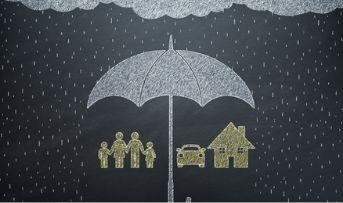
Material disclosures are key for a successful claim
Insurance policies can be tricky! You need to fully understand the policy terms & conditions before you sign the dotted lines. The government has set up many regulations to implement insurance rules in India efficiently.
Hence it becomes imperative to fill out the insurance policy papers yourself. If you do the formalities through an agent, you might face problems later. You need to know everything about the premium, risks, disclosures, etc. This can also cause the claim to be rejected in due time, which can be devastating, especially if you're in an emergency.
You should always be cautious about everything that you disclose to your insurer. This involves the disclosure of your materialistic goods, qualifications, medical history, income, bills, and so on. The more you disclose rightfully, the better. It is vital for all health and general insurance India. So, regardless of the insurance you're applying for, disclosure is essential.
Let's look at the things to disclose to your insurer while taking a policy or filling a claim, as they increase the chance of a successful claim.
1. Income:
It is one of the best things to be disclosed early on. Your income needs to be revealed whether you're employed permanently in a company or as a freelancer. The job designation, salary, and experience are also taken into consideration. The more experience one has, the greater their expertise. This also means that they are not eligible for hazardous work. All this contributes towards a successful claim.
2. Material possessions:
It is essential to disclose all the material assets that you have. From your house to your car, you need to declare them all. It also involves any land that you own. You should disclose anything materialistic as well as expensive at all times. Adding them later while raising a claim decreases your chance of getting a successful claim.
3. Occupation:
Your occupation directly correlates to occupational risk. It assesses the risk of accidents and even the wellness of an individual. The work done by the individuals is of prime importance. It helps in determining the claims as well. The risk assessment of a particular occupation also affects the premium paid by the individual for a health insurance policy.
4. Medical history:
Insurers give the medical history of the individual prime importance. It provides a brief insight into the history of illnesses an individual has suffered and the risk they bear. If it is more severe, the premium will go up significantly. Serious issues like heart disease, hypertension, and diabetes can increase the premium. They must be considered and disclosed to ensure you purchase the right policy with appropriate coverage that leads to successful claims in case of contingent events against which you are insured.
5. Family history:
This is an essential element that will determine the extent of the illnesses in individuals. If there are genetic disorders, it will also mean that the individual is at a greater risk of developing them. It can make the insurance company more cautious while assessing the individual's health or life insurance risk profile. Incorrect disclosure or misrepresentation of such facts leads to the rejection of claims.
You should reveal these critical elements to implement a successful claim. Material disclosures are of utmost importance as they determine the success of a claim. If not disclosed at the right time, they can cause problems later. You must follow these rules diligently while purchasing non-general and general insurance India. Good luck!
Click HERE to buy the best general insurance India.
Disclaimer: The information provided above is for illustrative purposes only. To get more details, please refer to policy wordings and prospectus before purchasing a policy.

Do you have a high credit score? You may be eligible for a lower insurance premium
Most people own numerous credit cards from single or multiple banks. While using a credit card does give you a specific advantage, not paying its dues on time can affect your loan and premium.
Have you heard about credit scores? A credit score is a term that describes a debtor's credibility, which is evaluated before availing of any financial services provided by banks or private finance companies.
Whether it is about taking a loan, applying for a credit card, or purchasing insurance, your credit score matters. It is considered to keep a high credit rating to ensure motor insurance India with a lower premium. Let's learn more about your credit score and how it affects your chances of lowering your premium charges.
What is a credit score?
A person's capacity to make timely debt payments is indicated by their credit score. In other words, a credit score is a numerical reflection of your creditworthiness. It is determined by several factors, including:
● Current loans
● Currently available credit
● History of repayment of loans and bills
Any bank will label a customer's credit rating with a numerical score ranging from 300 to 900. A person with a higher credit score is more likely to receive loan approval rapidly. Your credit score defines the level of financial risk you may represent to a financial institution when you seek a loan or insurance.
As mentioned above, an individual with a better credit score will likely get a car loan and insurance quickly. Moreover, they are also eligible for a lower insurance premium. Therefore, improve your credit rating for maximum benefits before applying for a loan or insurance.
How can your credit score lower your car insurance premium?
Banks and other financial institutions look for people with higher credit scores as they are more likely to pay their dues on time. Besides getting better loan options with a higher credit score, banks give insurance plans at lower premiums.
As a corollary, a low credit score may make you pay a higher premium for motor insurance India. Check your credit score, see what factors are affecting it, and identify what changes you can make to improve it.
How to check your credit score?
It only takes a few minutes for anyone to check their credit score online for free. Enter the essential details like name, mobile number, bank name, etc., and the tool will quickly determine your credit ratings.
While the free tool gives limited information, a paid tool with premium services gives exhaustive information about your credit score and tips to improve the ratings.
What is a good credit score?
A credit score of around 750 or above is considered a good credit rating. The higher your credit score, the more your chances of getting loan approval and better insurance plans. While increasing your credit score may seem challenging, you can improve it in minimum time with better planning and information. Here are some tips you can follow to improve your credit score:
● Always maintain your Credit Utilization Ratio within 30%
● Avoid using multiple credit cards at one time
● Ensure not to apply for loan applications in short periods
● Reduce the number of loans
● Pay loan EMIs and credit card bills on time
● Use credit cards within manageable limits
Besides these, you can talk with your bank to learn different ways to improve your credit score. It is necessary to keep your financial records as clean as possible as it impacts your credit ratings. Check your credit history today and work on the items that need your attention to reduce your premium for motor insurance India significantly.
Click HERE to buy reliable motor insurance India.
Disclaimer: The information provided above is for illustrative purposes only. To get more details, please refer to policy wordings and prospectus before purchasing a policy.

The best ways to clean the difficult corners or sections of your house
Your house might look clean, but is it completely dust-free? If you look closely in those corners, you will realise how much dirt has piled up. The filth in the tricky corners of your house is hard to clean and might eventually result in health issues due to the lack of hygiene.
Dust allergies are the most common problems faced in such situations. It becomes difficult for an allergy-prone person to live a normal lifestyle amidst unclean living premises. If you ignore cleaning dirty sections of your home, then it creates clutter. This impacts mental and physical health, affecting your behaviour, work, etc.
Having discussed some downsides of dust accumulation in the nook and corners of your house, it is essential to understand the solutions to the already identified problem. This blog will discuss the best ways to clean the problematic corners or sections of your house, so it remains clean and hygienic.
1. Be watchful about those spiderwebs:
Spider webs can be the bane of cleaning. They are challenging to remove and grow even in the narrowest corners of the house. The sticky spider webs also impact the appliances like fans that are often not cleaned.
You can use a dusting cloth with an extendable arm or handle to reach high and deep corners of your house. The cloth fibre will collect and clean the dust instead of scattering it around.
2. High cupboards and cabinets:
Cleaning the upper surface of high drawers, cupboards and cabinets is tough to perform. You will need a ladder and equipment which can pivot. This would help you reach far away corners and edges of the surfaces of various furniture.
You can use a microfibre or dusting cloth to clean the cupboards and cabinets so that the dust does not get scattered. Cleaning fluid can be formulated by mixing up dishwashing liquid, water, and ammonia commonly used in households. This can give you cleaner and shinier surfaces.
3. Cleaning the sinkholes:
All the remaining leftovers from your plates are usually accumulated in the sinkholes. If the size of the bits is less than the holes, they pass through the pipes. If not, they end up on the surface of the sink. It also results in the unnecessary clogging of the drainage pipes.
If not taken care of, they might release bad odour and even attract insects. You can use rubber gloves to remove the leftovers from the sinkholes and use cold running water to clean. Using baking soda or citrus peels to remove the foul odour is a good home remedy for sink issues.
4. Don't forget the washroom crannies:
Whenever you go to the washroom, take a closer look at the crannies. You will see spots that are difficult to remove. If not cleaned in time, these spots can get stubborn and are impossible to eliminate.
But don't worry. You can start by using a dry brush to scrub off the upper layer of these marks and spots. Use a cleaning liquid or warm water and soft scrub. Later, gently rub the surface to eliminate the layers steadily. And then, use a vacuum cleaner to suck the debris before giving the space a final wash with water and detergent (if needed).
Deep corners are home spaces that are neglected while routine cleaning and later create hygiene problems. Using these methods, you can easily access the difficult corners and ensure that your home is clean to its core!
Apart from deep cleaning, your objective must be to ensure your home's safety. Won't it be wise to discuss options to safeguard your home against large-scale unprecedented circumstances? There can be multiple situations that can be challenging for your house. To protect your safe abode, you must purchase the best home insurance policy in India to get the best coverage at the time of need. Magma HDI's home insurance is your best advantage to have safer homes and good peace of mind.
Click HERE to learn more about the benefits of India's best home insurance policy.
Disclaimer: The information provided above is for illustrative purposes only. To get more details, please refer to policy wordings and prospectus before purchasing a policy.

How to deal with unexpected travel expenses and ways to avoid them
Travel is a great way to expand one's horizons. It gives you a different perspective and is necessary to re-energise the mundane lifestyle. It is a great way to rejuvenate yourself after a hectic schedule and become more productive and enthusiastic at work.
However, it's a well-known fact that travel can get expensive. From finding the right flights to booking the right hotel, a lot needs to be done, and the challenging part is the hefty unexpected expenses. So, to save you from falling prey to the hidden cost charged by hotels, airlines or travel agencies, this blog gives you an insight into mindful travel techniques.
1. Baggage fees:
Airlines charge massively for excess baggage. Extra luggage means extra cost. It is impossible to unpack luggage at the last minute. Therefore, always carefully check the size and weight requirements and pack accordingly. Keep a habit of packing light and avoid stuffing your bags with unnecessary things. You may also practice vacuum packing, which helps keep your bags clutter-free.
2. The pesky phone bill:
We live in a digital age where smartphones are crucial to travel for safety and convenience. Be it clicking photos, talking to new people using translation, booking cabs and hotels, everything is done using our phones these days.
If you are planning a long trip to a foreign destination, it is imperative to know that international roaming charges cost a fortune and will drain your funds if not managed mindfully. For an extended travel period, it's better to buy a local sim to save money.
3. Departure Taxes:
One of the most unexpected and annoying expenses is a departure tax. Some countries charge you money for simply exiting their country. This also applies to the layover at these places. Browse the internet thoroughly so you don't get blindsided.
4. Transportation:
Transportation has been made very easy in many regions worldwide, which might be why new travellers often overlook this expense. But getting out of the airport and taking a cab to the hotel might cost you a significant amount of money.
To avoid this situation, thoroughly research the modes of transport available in the place you're visiting. Choose public transport if that is an option. Better yet, find a hotel with transportation included in their services.
5. Emergencies and medical expenses:
When travelling to a new place, especially if you're visiting another country, it's important to remember that the food, drink, and lifestyle of their habitants might not suit everyone. There is a chance of falling sick, and one must be prepared for all emergencies. Prepare a first aid kit and a stash of the common medicines for general problems like headaches and stomach aches.
Falling sick in another country costs a fortune, especially because foreigners are not included in the national healthcare system. While this cost is unavoidable, checking insurance policies online that fit your needs will help reduce your spending.
6. Trip cancellation:
Cancelling a trip is something no traveller wants to experience. You'll lose a significant amount of money on something you didn't even get to enjoy. An excellent way to avoid these expenses is to research the best and buy insurance policy online. These policies may reimburse you for the flights and sometimes even the hotels you're staying at.
Always keep some extra funds with you to buy small souvenirs and make the trip more memorable. Although we wish for the best in every situation, it's wise to be prepared for less than ideal situations. Buy insurance policy online to rest assured during the trip. With these effective tips, you can cut costs without compromising on the fun part of your trip. Happy travelling!
Click HERE to buy insurance policy online.
Disclaimer: The information provided above is for illustrative purposes only. To get more details, please refer to policy wordings and prospectus before purchasing a policy.

Best tips to travel like a vegan
Veganism is a new trend that has drawn the significant attention of Indians. But, what is veganism? The dictionary defines veganism as the practice of eating only plant-based food. For example, plant-based alternatives to your regular cow’s milk are almond milk, oat milk, soy milk, etc. Consumerism has given veganism a new branding, which means an abundance of mock meat, vegan cheese, vegan butter, tofu, etc., in the western and European markets. The list is endless.
An average Indian’s meal plan is predominantly vegetarian, consequently vegan. Hence, more often than not, people eat what is readily available. However, if you intend to travel as a vegan, you might lack options to meet your daily dietary needs.
In this article, we will look at everything you can do to ensure that you enjoy your vacation without compromising your food preferences.
1. Fruit and vegetables:
While travelling, take a tour of the local stores and buy seasonal fruits and vegetables. Vegetables such as cucumbers, tomatoes, onions, beetroots, etc., are great ingredients for salads and sandwiches. You can prepare either of the options in your hotel and carry it with you for later use. Chop and store them in a tiffin inside the mini-fridge provided by the hotel. This will ensure that you always have a backup in case you can't find anything outside.
2. Carry vegan snack options:
Make a run to the nearest convenience store and pick up vegan options that suit your taste. Cup noodles, bread, protein bars, nuts, etc., are convenient and readily available vegan options that you can bank on. You can rest assured that you have ready-to-make food options available during emergencies.
3. Explore vegan restaurants and eateries:
Travelling is all about exploring and trying new things. Include restaurants and dishes that you never tried before in your itinerary. Talk to locals to understand the vegan culture in the places you visit.
This is an intelligent way of knowing all the good vegan places to visit. Veganism is a trend that has been growing for the last few years, which is why many restaurants have a good selection of unique vegan dishes.
4. Talk to your hotel:
Before booking your accommodation, you can talk to the hotel and notify them of your needs. If your hotel provides concierge services, they will know the best places to visit and try local dishes and vegan food. Most hotels also offer vegan food options.
However, if your hotel does not have vegan options, you can consider looking for other hotels. Look out for private villas or homestays. These are equipped with all necessary items such as a gas stove, fridge, and oven, making it easier for you to cook meals yourself.
5. Talk to the chef:
Most people still find it difficult to gauge the difference between vegans and vegetarians. This is why it becomes challenging to keep track of the food and ingredients that go into a meal. Tourists prefer to say that they are allergic to certain ingredients. Talking to the chef is the best way to ensure that these ingredients are not added to your dish. The world is still new to the idea of vegan butter and vegan cheese, so providing adequate information to the chef is essential.
These are a few ways to ensure a stress-free trip with your vegan choices. An important tip is to learn a few phrases in the local language to let somebody know of your allergies and food preferences.
Your food choices should be a matter of joy in your life. Do not forget to experiment with new cuisines and dishes for a wholesome travel experience. Travelling vegan might still be easy, but travelling without proper safety is challenging. As a responsible traveller, do not forget to buy general insurance online to ensure your safety during travel. General insurance acts as a safety net for you and your loved ones for any unprecedented expenses you might face.
Click HERE to buy general insurance online.
Disclaimer: The information provided above is for illustrative purposes only. To get more details, please refer to policy wordings and prospectus before purchasing a policy.

Decorating your baby's room? Here are the themes you can work with
"To-be" parents enjoy investing time and money to transform their child's room into a small world where their baby feels comfortable. They carefully plan and curate their thoughts about the room, including toys, fancy paints, and furniture for the newborns.
These elements just don't make the room attractive but develop an interest in the child. As babies have excellent observation skills, decorating their room with colours and playful stuff will help them enjoy new experiences.
Parents get tensed while selecting the theme and the other decorative articles. There are various options available in the market, which make the to-be-parents more confused. We are here with a few fantastic themes you can choose from. You can browse through the blog and think of ideas with fresh perspectives. Add a personal touch and get ready to welcome your newborn into the world!
1. Space-time exploration:
You can decorate your baby's room with various maps, flags of different countries, ships, rockets, space shuttles, planets, stars, the sun, the moon, and other images that will bring curiosity. You can also use glow-in-the-dark stickers of the stars and the planets to cap off the night sky.
2. Let's go to the zoo:
A zoo decor would be a great idea to give the room a natural and jungle look. You can create grasses and graphics of different animals and birds to excite your baby. Use colours that pop off to stimulate your child's mind and develop their brains from a very young age. You can also put up a small canopy in the room, giving it a "camping in the woods" feel to engage your child’s creativity and interest in learning new experiences.
3. Beneath the ocean:
Paint the whole room blue. You can depict the diverse life forms in the ocean. Put up pictures of cute whales, sharks, fishes, jellyfishes, coral reefs, etc. Make use of glow-in-the-dark jellyfish stickers displaying their original nature and give the room a complete underwater look. You may put up a bedsheet with designs of fishes or buy cushions in the shape of sea animals to bring more marine character to the room.
4. Cartoon characters are fun:
You can draw and paint famous children's cartoon characters and elements from favourite cartoon shows. You can paint them yourself or call an expert to decorate your baby's room. Select different props from the show, and put the soft toy versions in the crib, chair, or floor.
5. Kids love beaches:
Babies love playing in the sun. And beaches are a whole carnival for them. You can use light yellow wallpaper to display the sand and decorate it with stickers, pictures, or other marine items and plushies of seashells, crabs, forts, oysters, etc. This would complete the beach vibes you want to create.
These were a few exciting theme ideas that you can implement while decorating your child's room. Take your time, research thoroughly, and design a room your baby will enjoy. After all, your baby will be spending most of its developing years in that room.
To be a parent brings many responsibilities. Along with the decoration, it would be wise to consider protecting your home. A home is where you make the most of the memories with your children and loved ones.
The damages to home come uninvited, but you must be prepared beforehand to tackle all the mishaps. Damage to property due to theft or natural disasters can drain your pockets. So, invest in home insurance India to put less monetary pressure and assure guaranteed compensation for these damages. Reap the benefits of providing hassle-free protection for your home and make endless memories with your family.
Click HERE to know more about how you can buy home insurance India.
Disclaimer: The information provided above is for illustrative purposes only. To get more details, please refer to policy wordings and prospectus before purchasing a policy.

Planning your first cruise trip? Here's all you need to know
Watching the beautiful horizon from the open deck is a mesmerising experience. Cruise trips seem elite and sound exciting. It is a paradise for ocean lovers. From solo ventures to family getaways, the cruise journeys welcome travellers to enjoy an unforgettable maritime holiday opportunity. Sailing couldn't have been more fun with several recreational activities, games, and cuisine organised onboard. Every moment on the ship reflects a beautiful memory to cherish forever!
Planning your first cruise trip can seem daunting without proper information about bookings, the right time to travel, the expenses, and much more.
This blog is your guide to understanding all the information you need to know before you board the ship. Carefully go through the pointers and chart all the requirements to plan a hassle-free cruise trip. Here’s all you need to know.
1. Timing is everything:
You need to figure out the right time to sail. Finalise your destinations and understand their sailing season. Look up the details of the touchpoints and the locations you wish to visit on the cruise company’s website or reservation site and research their sailing calendar.
2. Choosing the right cruise:
Different cruise liners provide you with various amenities and a range of activities to do while you’re on your sea voyage. Carefully look at different packages and determine which one fits your vacation goals and budget. Choosing the right cruise is important as they will take you on a journey to foreign countries and continents. Multiple onboard activities will keep you engaged throughout your travel.
3. Intent of travel is important:
Determining how and why you wish to take a cruise trip would be best. It is essential to determine your travel purpose as you will be out in the sea longer than expected. And when there are fewer locations to step down and explore and more sea exploration, things can get a little challenging due to the feeling of stagnation. Hence it is essential to figure out how confident and strongly willing you are to take a sea voyage.
4. Book the cruise:
While planning your first-ever cruise trip, you should book with someone trustworthy. Or some of your close contacts have already experienced their services and recommend them. Given the time of the journey and the heavy expenditure, you must ensure to do research regarding the company before you go ahead and book your tickets.
5. What should your itinerary look like:
Foremost finalise your budget and the location before you head out in search of the best cruise trips and their itineraries. Fixing your budget will help you narrow down your list of options and help you efficiently choose the suitable itinerary that covers all your expectations.
6. Choosing the perfect cabin:
You will have several options to pick from when you are finalising your cabin for the cruise journey. But how to choose the right cabin? If you’re easily seasick, looking for cabins with a sea view will not be advisable. You can choose higher or lower cabins according to your preferences, which do not face the sea but open your doorway into the activity area, making you feel more alive!
Certain other pointers like checking on your travel documents: your passports, visa, identity proof, tickets, etc., are paramount. Keep your health as the priority. Make all necessary preparations regarding the medications you might need beforehand to avoid the stress of getting sick when onboard.
While planning your first cruise trip can be stressful yet exciting, it is always helpful to be prepared for any travel or medical emergencies in advance. Unprecedented circumstances can result in panic situations while travelling. Don’t let health emergencies spoil your excitement of enjoying your first cruise trip.
We advise you to browse through Magma HDI’s general insurance plans and purchase the one which would cover your travel insurance in the best way possible. Purchase the best general insurance plan and sail carefree. Bon voyage!
Click HERE to know more about how general insurance plans can make your travel experience risk-free.
Disclaimer: The information provided above is for illustrative purposes only. To get more details, please refer to policy wordings and prospectus before purchasing a policy.

Wallpapers or Texture paints: Which is the best for your home walls
If you are buying a new house or renovating the existing one, having the perfect and attractive walls should be your focus. The most prominent part of your home is the walls. They capture many memories and provide a lot of scopes to try out new styles and give your home a refreshing touch.
Investing thought, time, and money in decorating the walls will turn your home into a more welcoming space. But how do you finalise the look of your walls? Would they look better with wallpapers, or would texture paints achieve the finish you attempted?
We will try to cover all your wall decor questions. Let's get started!
1. Types of texture paints:
Various forms of texture paints, including emulsions, distempers, etc., are available in the market. They can either be water or oil-based and are used for different purposes. You can use solid colours and texture paints to give your walls a bold look. Apply other techniques to create patterns and textures on your walls to give them a zing.
2. Wallpapers:
Wallpapers come with a variety of patterns and textures. Using the right tools and proper measurements, you can stick them on your walls. They come with a solid adhesive and are easy to paste. You can pick the wallpaper's designs as per your taste and the look you want to achieve for the walls.
Wallpapers and texture paint – how are they similar?
● Both are available with many options and shades
● Both have tailor-made options to match your usage and decor plans
● Both require some pre-preparation time to set things up
● Both help you achieve your decor goals
Wallpapers or texture paints: Which is the best for your home walls?
If you are starting from scratch (a blank wall), both wallpapers and texture paints require a similar time to set things up and get started. But removing any wallpaper or colour is a tedious job. After removing the previous coat, you must prepare the wall before pasting the wallpaper or starting with the primer for the texture paint.
Application of wallpaper takes less time as compared to texture paint. You need to apply at least two coats to achieve the texture and pattern you aim for, while it takes about twenty-four hours for the wallpaper to stick appropriately and achieve the best finish. Texture paints can take up to forty-eight hours or more.
Textured paints are your best bet in bathrooms and kitchens. High moisture does not gel well with adhesives. Hence, applying wallpaper in the bathroom and the kitchen would be a massive waste of resources, and there's a risk that it might come off or get wet and torn. Variations of textured paints can be used outdoors, while wallpapers are more appropriate for enriching the interiors.
You might need help from professionals during the application of wallpapers. Textured paints and wallpapers are both cost-effective, but wallpapers might get a bit expensive if you are looking for a specific design.
Now that we have discussed the significant aspects of the two options, you can make a decision. And while you are at it, consider protecting your home against unforeseen circumstances and tragedies. You would want your home to be safe from unexpected problems that take a massive toll on your finances and happiness.
Fret not! This is avoidable with the provision of purchasing home insurance. You can explore your options and buy the best home insurance in India which suits your needs. Carefully look at all the terms and conditions before finalising the deal. There are multiple home insurance options that can help you have the best premium and provide extended coverage.
Click HERE to know more about the best home insurance in India.
Disclaimer: The information provided above is for illustrative purposes only. To get more details, please refer to policy wordings and prospectus before purchasing a policy.

Here are a few ways you can use to make your balcony a cosy space
A cup of tea, a favourite book, and some music in the background while you feel the sprays of monsoon on your face. That’s what dreams are made for your casual & chic home. We all have unique ideas of our happy space and how we want to decorate them according to our tastes. Some of us are truly blessed with good aesthetic sense, while others have to depend heavily on the internet for ideas and inspiration.
After spending hours on various websites and choosing the best options, you create the perfect room for yourself. What about your balconies? This article will discuss some exciting and economical ways to revamp your balcony to make it the perfect cosy space for you to unwind.
1. Plants are the perfect backdrop:
Adding plants is one way to add colour and freshness to your balcony. You can opt for flowering or nonflowering plants depending on your choice. If you are a beginner, go for low-maintenance plants like the snake plant, money plant, spider grass, etc. You can also use different prints and colours on flowering pots to add more character to the balcony.
Artificial turf is a game-changer if you want more greens with minimum effort. Homeowners use these to give their balconies the feel of a miniature carpet garden that adds more comfort and cosiness to the entire space.
2. Sitting arrangements beyond ordinary:
Since your balcony is susceptible to rains and sun, one way to ensure the sitting area is not perishable by using metal chairs and tables. These bring a certain antique charm to your balcony without overbearing on your pocket. You can also add swings to make it more fun and quirkier. Adding rugs, floor pillows, and pouffes can make the space seem instantly cosy, and in the event of rain, you can quickly put them back inside.
3. Add lights for vibrant nights:
Adding tiny yellow lights and lanterns is probably the best way to make your balcony beautiful and warm for the evenings. You can further add scented candles if you have visitors, making it the perfect hangout spot for you and your guests. This way, you may even bring the romance right to your balconies and plan perfect dinner dates with your beloved or instead just indulge in your favourite pass time.
4. Textured wallpapers:
Using textured wallpapers can bring a new life to your balconies. Depending on the plants and other furniture used, you can either select a bright pop of colour or an understated neutral look. Wallpapers are a foolproof way to instantly elevate the interiors and add a certain elegance to the space.
5. Shade and privacy:
Most people do not spend time on their balconies because of a lack of privacy or unfavourable weather conditions. Use an awning or extended coverage to protect your balcony from direct sunlight or rains. Opting for a retractable or a folding roof is a choice that you must consider to change and alter the look of your balcony.
These are a few ways to turn your old balcony into a cosy living space. Remember to not go overboard with the decoration. A cluttered space kills the purpose of building a comfortable space for yourself. Talking to an interior designer or an architect can help you understand how you can modify the area without spending a lot of money.
Add value to your home and memories by investing in home insurance. Home insurance is a safety net for you and your family that will help you in case of any damages or losses. Along with beautification, you need to ensure your happy place's safety from mishaps like theft, fire breakout, etc.
Click HERE to learn more about home insurance plans.
Disclaimer: The information provided above is for illustrative purposes only. To get more details, please refer to policy wordings and prospectus before purchasing a policy.
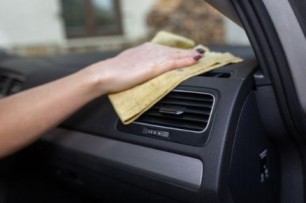
Best ways to clean the dashboard of the car along with its internal components
Owning a car promises exciting and thrilling adventures. Whether going on long road trips, making impromptu plans to meet up with your friends, or simply driving around the town while playing music, these are just a few of the benefits of owning a car. Every car owner wants to keep a well-maintained vehicle with glowing interiors and dashboard.
But how can you maintain a shiny car dashboard? The dashboard has nooks and corners that can quickly accumulate dust particles. Many of us eat inside the car, making it susceptible to spills and oil stains.
In this article, we will take a look at a few ways in which you can ensure the cleanliness of your dashboard.
1. Dusting:
One of the easiest yet most efficient ways of cleaning the dashboard is by dusting it regularly. Spare five minutes of your time to wipe down the entire dashboard with a dry cloth before leaving your vehicle. This will help reduce the build-up of dirt and dust and help in easy cleaning every time. You can also use a tiny brush with soft bristles to reach the crevices and folds that are not easily accessible by hand.
2. Vacuum:
Using vacuum cleaners once every month is another good way of ensuring clean dashboards. Vacuum cleaners help pick up tiny dust particles within the vents and buttons. This also increases the efficiency of ducts and helps with faster cooling when you turn on the air conditioner.
3. Cleaning solution:
Using a cleaning solution on the dashboard helps get rid of any greasiness. Spray some cleaning solution onto the surface of the dashboard and clean it thoroughly. Once done, use a damp cloth to wipe down the parts to avoid staining. Follow this up with a dry cloth to get rid of any residue. Remember to do this in small batches to ensure that the solution does not dry and leaves any patches on the surface.
4. Sanitise:
Since the dashboard is the most accessed part of the car, sanitising the drawers, buttons, steering, etc., is a good idea. Even if you are the only person using the vehicle, it is good to sanitise the area to prevent germs and bacteria.
5. Take special care of the infotainment unit:
Everyone inside the car often uses the infotainment unit. Use screen wipes and a microfiber cloth for best results. Microfiber can pull up dirt without causing any harm to the screen. Avoid using chemicals directly as you will constantly be touching the unit and are susceptible to being in contact with the same. Using harsh chemicals can also lead to damage to the anti-glare coatings on the console.
These are a few ways in which you can clean the dashboard. Proper cleanliness ensures good health for you and your co-passengers. Clean and stain-free interiors make a statement and provide credibility to the excellent maintenance of the vehicle.
If your interiors are neglected too often, you might need to change the unit entirely, which can be expensive. Add value to your car by investing in an insurance plan with a good motor insurance company. Getting the best deal on an insurance policy can be beneficial for you, in the long run, to stay stress-free regarding the expenses associated with your car.
Click HERE to know more about motor insurance company.
Disclaimer: The information provided above is for illustrative purposes only. To get more details, please refer to policy wordings and prospectus before purchasing a policy.

Here's the list of seven surprisingly strange things that can be covered by home insurance
We all know the importance of investing in home insurance. It covers the cost of repair work and modifications in case of damages. However, there are various aspects of home insurance that you might not be aware of.
Let's look at some surprisingly strange things that might be covered under your home insurance.
1. Space debris:
Damage to your property caused by meteors, airplanes, rockets, satellites, etc., is covered under home insurance. The risk from these is listed as environmental hazards. Space debris includes both man-made things and naturally occurring objects.
Any damage caused by this debris to the structure and the homeowners' belongings is covered under home insurance. If you get injured on the premises of your house, the insurer is liable to provide you cover for all the medical expenses you incurred during your treatment.
2. Damage from plane and vehicle crash:
A plane crash in housing areas can lead to severe property damage and injuries. Other instances of crashes are when cars swerve off-road and crash into the house. Damages and injuries resulting from these crashes are also covered under the home insurance policy.
Under these circumstances, the party that caused the crash is liable to make monetary compensations for the damages incurred. If, however, their payout is limited, then your insurer steps in and pays for the rest of the expenses.
3. Damage due to civil disorder:
Any explosion, bombing, etc., arising from civil commotion can lead to property damage and vandalism. These situations lead to severe expenses and maintenance work due to heavy destruction. Property damage arising from fire, broken windows, etc., are also a few instances. If you are unable to reside inside your home due to these conditions, your insurer will cover additional living expenses such as hotel bills, meals, etc.
4. Floods and other natural disasters:
Due to increasing global warming, there has been a severe increase in natural disasters. Any damage incurred during these disasters is also covered under home insurance. Note that most insurers do not cover these, so look for insurance policies that include these factors.
5. Upgrades:
Any upgrades or modifications made due to new regulations from the local government are covered under home insurance. Opting for ordinance coverage is an excellent way to ensure that your insurer handles these expenses. Under this feature, the insurance company is liable to pay you the cost of overhauling a home or building to comply with the up-to-date building codes.
6. Identity theft:
Identity theft is a massive problem across the globe, and many fraudulent activities occur because of this. Insurance providers cover the cost of all the expenses, from legal fees to the reapplication of loans.
Insurance providers are there to help and support you in case of emergencies and other mishaps. Spending ample time on research and reading through the policy papers to ensure that you are choosing the best home insurance will help you in the long run.
Click HERE to know more about home insurance.
Disclaimer: The information provided above is for illustrative purposes only. To get more details, please refer to policy wordings and prospectus before purchasing a policy.
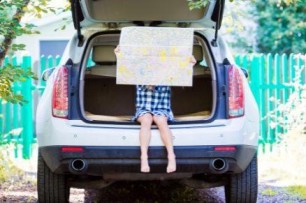
Know more about different ways to handle the weird mood swings of kids while travelling
Although travelling with kids is fun, it can also be challenging at times. Children are difficult to control and have to be constantly looked after no matter where you are. While parenting is blissful, it can be stressful during travel.
You need to ensure that you carry enough supplies for the trip, pack your essentials, and anticipate everything your kids might require during the journey. It also depends on their age, as younger kids need more attention than those old enough to carry their bags and take care of themselves.
Kids can get iffy while traveling for multiple reasons, including an unfamiliar atmosphere, too many people, deviation from the routine, and much more. But how to handle it when they get all worked up? This blog will answer that for you. By the end, you will know more about the different ways to handle your kid's mood swings while travelling.
1. Keep small toys handy:
You can distract your kids with their favourite portable toys. This will give them a sense of familiarity and allow them to have fun and stay unaffected by the crowd or the unfamiliar surroundings around them.
2. Food breaks:
Try to give your child quick snacks on the go like chocolates, biscuits, chips, or other food items they like. Giving them food and water breaks keeps their stomach full and can even help them drift off to sleep for the rest of the journey. This would keep the kids stress-free during the trip and be helpful for the parents.
3. Cartoons and shows:
Entertainment is always a saviour when it comes to calming kids during travelling. You can download their favourite shows and cartoons before heading for the trip. This will keep them occupied, and they won't be much bothered about their surroundings.
4. Activities can help:
Parents can pack different supplies for some exciting activities that the kids can indulge in. This will serve as a learning purpose while also keeping them busy. You can carry crayons, pencils, papers, board games, tokens and dice, comics, storybooks, etc., for the children to keep themselves occupied with. These pastime pursuits will engage them and enrich their knowledge while keeping their mood swings at bay.
Another easy way is to give your kids a gaming console to keep them occupied and have a relaxing trip. Next, carry travelling essentials for kids, pack their backpacks, and give them the responsibility to handle them if they are old enough. If you are travelling with a newborn, carry their diapers, warm water, milk, and a sipper.
These are some tips and tricks that parents can use to help their kids stay calm while travelling. Often children might get sick on trips, bringing you and your children into unprecedented situations. It is crucial to invest in an insurance plan to stay stress-free and protect yourself and your kids against any health-related emergencies or other unforeseen mishaps. You can check out all the available options and easily buy an insurance policy online.
Click HERE to know more about how you can buy insurance policy online.
Disclaimer: The information provided above is for illustrative purposes only. To get more details, please refer to policy wordings and prospectus before purchasing a policy.
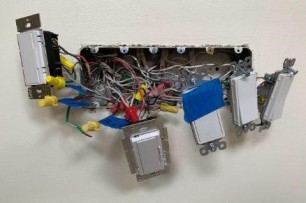
A guide to change the old wiring in your house
Upgrading electrical wiring makes an old home more secure, modernised, and habitable. This kind of renovation is easier in a recently acquired property than in an older one. Unless you have prior expertise with electrical construction, do not try to change wires on your own.
Most people instantly think of the costs and clutter involving the job. Your strategy is determined by your budget, capacity to reach the walls, ceiling, crawlspace, and the amount of rework permitted.
To clear the confusion, below are the typical steps involved in changing the wiring of a house.
1. Planning:
The better you prepare for the rewiring, the easier the procedure will be. A precise design will assist you in locating and projecting the circuits in a manner that will retain the drywall in place. A thorough layout of the existing circuitry and a precise sketch of the internal components may minimise chaos and disturbance.
2. Working prep:
This step prepares the space for the new wiring. It marks a clear route for supplying the new wire to the outlets. If you opt to undertake the prep work, clearing debris around your house's electrical outlets is crucial to ensure quick access.
3. Calculating the number of circuits:
Many times, outdated wiring may not have enough circuits to meet the energy needs of contemporary appliances, lights, and electronics. Before you begin, you must first plan your trajectories. Conduct a study on housing circuits to aid in layout planning, or contact an electrician as a consultant.
4. Remove the drywall and rewire:
The removal step consists of ripping out and taking off the old wire. Because old wiring is often stapled to the structure, it is impossible to simply take the cables out of the wall. After ensuring that the electricity has been turned off, you may cut the wire and remove the visible portion, leaving the buried cable within the division.
Some wires are placed in more accessible areas and can be taken out quickly. You can tape the new wire to the old ones, pull the old wiring out, and let the new line fall into its spot and take effect.
5. Replace:
Replacement of main and sub-panels is one of the essential steps to changing the old wiring in your house. Also, ensure that you check the condition of the panel. If it's old or does not have circuit breakers in place of fuses, it is better to replace them to prevent further damage. Replacing the panels would also require changing the wiring of your entire house. Try to find a professional electrician to accomplish this task.
Some other steps to change the old wiring in your house include:
• Taking permits from the local authorities (even if you are a homeowner).
• Hiring a good electrician.
• Identifying the access points.
• Having the right tools to complete the work and taking stringent measures to ensure everyone's safety.
It is essential that the rewiring be done correctly and by skilled specialists. If not done properly, the wires might get nicked and lead to short circuits. Furthermore, if the panel and junction boxes are not connected, it might create radiation, negatively affecting your health and even hampering the condition of your house.
Your house is your safe space. It is where you and your family live and create memories. Hence, it is essential to safeguard your home. Invest in a robust home insurance plan and protect your home from unexpected hazards. You can review the available insurance plans and purchase the best home insurance policy in India that offers you great benefits at a reasonable premium.
To get the best home insurance policy in India, click HERE.
Disclaimer: The information provided above is for illustrative purposes only. To get more details, please refer to policy wordings and prospectus before purchasing a policy.

Lost your phone in the crowd? Here's what you need to do
Smartphones are rapidly becoming an integral and inseparable part of our lives. These devices contain a mini virtual world within them that engrosses us with extensive features and seamless specifications. It has everything from the type of cuisine you like to what skincare serum you last purchased. Your social media account details, bank details, countless passwords, contacts and information are all stored in it.
But, what do you do if you lose your phone? In today's world, losing your phone can have significant consequences. Your details can get leaked or erased. Your money can be stolen if your account gets hacked, or you can lose important information.
The majority of phone lost cases are observed in overcrowded places, and, in some cases, the smartphone users forget their phone at public places like restaurants or shopping malls.
So, what if you have just lost your phone somewhere? Here's what you need to do to minimise the damage.
1. Keep trying your number:
It would be best to text or call your phone. The ringing would help you track it. And if your phone is lost (and not stolen), somebody would be able to answer your call and return your phone upon further communication.
2. Report:
Report the loss of your phone to your cell phone carrier. They can help you determine your phone's current location using your number. This could make it easy to retrieve your phone if it's lost in a vast crowd.
You can also deactivate your sim card to ensure that nobody can make threats and illegal fraud calls from your number.
3. Lock:
Try to lock your phone remotely. This will secure your device and restrict others from accessing your personal information. You'll get notified if someone resets it.
You can try deactivating your device too. In the case of iOS devices, you can activate "Mark as Lost", which disables your phone and send a confirmation mail to your email address.
4. Track:
You can track your phone using the GPS if you have the option active on your phone. In the case of an android device, you can log into your Google account (the one you use on your phone) and track your phone's current location using Google location history. This feature is beneficial sometimes, especially if your phone is nearby.
5. Clean:
To ensure that nobody gets access to your social media accounts and other personal information, try to wipe your phone clean if it goes missing in the crowd and you cannot retrieve it. You can use iCloud or Android device manager to erase your data from your device. Also change the passwords of all your bank accounts, social media handlers etc.
6. Monitor:
Try to monitor the activities of your phone. Keep track of any malicious and suspicious activities performed using your phone or number. Get in touch with authorities (police and phone carriers) and inform them if you find something fishy.
When you lose your phone in a crowd, contact your card companies and ask them to lock your cards and unlink your accounts so that nobody gains access to them.
The loss of your smartphone is worrisome. Insure your valuables to add an extra layer of security in case of unavoidable circumstances. You can purchase online general insurance by browsing through several options and purchasing the one that offers maximum benefits.
Click HERE to know more about how you can purchase online general insurance.
Disclaimer: The information provided above is for illustrative purposes only. To get more details, please refer to policy wordings and prospectus before purchasing a policy.

How to Secure Your Home Against Calamities?
It's an old adage "New or Old - Home is where the heart is". Whether you have moved into a new house or have just had your entire house renovated, you want to make sure that it is safe from calamities. You need to make sure that you can reduce the damage to your house in case there is a natural disaster and that you won’t need to pay a hefty amount trying to fix that damage. One of the best ways is to always have home insurance. With there being so many in the market, it isn’t that difficult to find the best home insurance in India. Here are some ways to secure your home against calamities: -
Get Home Insurance: Always having home insurance in place is one of the best ways to protect your house from any calamities. Home insurance will cover a certain proportion of the costs of repairing or will protect against any damage due to fire, a flood, an earthquake or other such disasters. So, if there were to be a calamity, you wouldn’t need to pay for all the costs of repairing from your own pocket; the insurance company will pay for most of it. Do a little research and choose only the best home insurance in india.
- Have a strong foundation: If you live in a house and not an apartment in a building, make sure to bolt the house to the foundation. When constructing or renovating the house, make it a point to secure the house to its foundations so it won’t be uprooted when there is an earthquake, especially if you live in an earthquake-prone region.
- Know how to turn off the utilities or electricity: When there is a natural disaster, the chances are that you won’t really have a lot of time to turn off all the electrical switches, water taps or the gas. So, you must always be prepared. Know where the main electrical board is or where the main source of the gas is, so you can just turn them off during an emergency instead of scampering around trying to turn off individual taps or switches.
- Do not put off any repairs: Whether there is a tap leaking, a hole in the wall or the roof, or the door isn’t properly hinged to the wall, do not procrastinate when it comes to fixes these problems. You cannot predict a disaster, and when it does hit, the slightest gap or the smallest hole will allow water to enter into the house and eventually flood it. In case of a storm or tornado, a loose door could ultimately break, and you wouldn’t have much protection from the strong winds or the damage they may cause.
- Try to use fire-proof materials: Trying to construct the house entirely with fire-proof material is not possible. However, the wires used must be all fire-proof. During a natural disaster, wires can possibly cause a fire, and using water to put it out would only be more dangerous. So, you must make sure that the wires you have running all over your house will not catch fire.
Being a homeowner, you need to keep a lot of things in mind to ensure that your property is safe from any damages and a natural disaster is something no one can predict so the only option is to be fully prepared.


